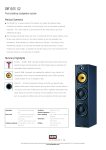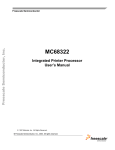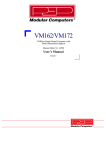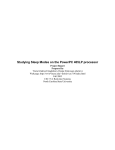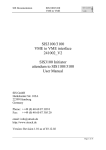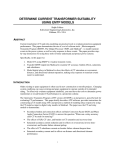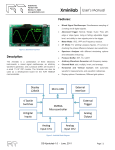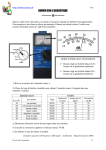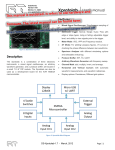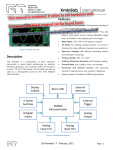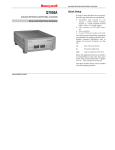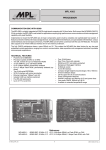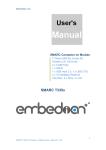Download VSBC-32 - Kontron
Transcript
VSBC-32 Combined VMEbus System Controller and Serial Communications Controller Board Manual ID 21168, Rev. Index 04 Jul 00 The product described in this manual is in compliance with all applied CE standards. General VSBC-32 Revision History Manual/Product Title: VSBC-32 Manual ID Number: 21168 Rev. Index Brief Description of Changes 0100 Initial Issue 00/1 Aug 95 0200 General corrections 00/2 Dec 95 0201 J9 default setting changed 00/2 Nov 96 0300 General corrections and new manual structure 01 Dec 96 0301 New Preface 01 Aug 98 0311 Improvement to Fig. 2.1.3. In Appendices, corrections to flash addresses on pages MEM-2 to MEM-4, page MEM-5 replaced. 01 Sept 98 04 Information of Errata Sheets 0100_1/2 integrated, adequate manual structure, new memory piggybacks mentioned, description of combined system and communications controller fucntionality, function-related board diagrams, coherent terminology (e.g. processor and board variant names) etc. Appendices modified, updated, reduced. 01 July 00 Board Index Date of Issue Imprint Copyright © 2000 PEP Modular Computers GmbH. All rights reserved. This manual may not be copied, photocopied, reproduced, translated or converted to any electronic or machinereadable form in whole or in part without prior written approval of PEP Modular Computers GmbH. Disclaimer: PEP Modular Computers GmbH rejects any liability for the correctnesss and completeness of this manual as well as its suitability for any particular purpose. This manual was realized by: TPD/Engineering, PEP Modular Computers GmbH. Page ii © 2000 PEP Modular Computers GmbH ID 21168, Rev. 04 VSBC-32 Contents Contents Preface Preface ..................................................................................................................... ix Proprietary Note ....................................................................................................... ix Trademarks .............................................................................................................. ix Explanation of Symbols ............................................................................................ x For Your Safety ........................................................................................................ xi High Voltage Safety Instructions .............................................................................. xi Special Handling and Unpacking Instructions .......................................................... xi General Instructions on Usage ............................................................................... xii Two Year Warranty ................................................................................................ xiii Chapt Chapter 1 1. Introduction ................................................................................................. 1 - 3 1.1 System Overview ....................................................................................... 1 - 3 1.2 Board Overview ......................................................................................... 1 - 4 1.2.1 Board-Specific Information ................................................................. 1 - 4 1.2.2 Board Variants ................................................................................... 1 - 4 1.2.3 Board Connectivity and Interface Expandibility .................................. 1 - 5 1.2.4 Memory Piggybacks ........................................................................... 1 - 6 1.2.5 System-Relevant Information ............................................................. 1 - 6 1.3 Board Diagrams ......................................................................................... 1 - 8 1.3.1 System-Level Functional Block Diagram ........................................... 1 - 8 1.3.2 Frontpanels ........................................................................................ 1 - 9 1.3.3 Board Layouts .................................................................................. 1 - 10 1.4 Technical Specifications .......................................................................... 1 - 12 ID 21168, Rev. 04 © PEP Modular Computers GmbH Page iii VSBC-32 1.5 Contents Applied Standards .................................................................................... 1 - 14 1.5.1 CE Compliance ................................................................................. 1 - 14 1.5.2 Mechanical Compliance ................................................................... 1 - 14 1.5.3 Environmental Tests ......................................................................... 1 - 14 1.6 Related Publications ................................................................................ 1 - 15 1.6.1 VMEbus/CXC Systems/Boards ........................................................ 1 - 15 1.6.2 Manufacturers’ Component Documentation ..................................... 1 - 15 Chapter 2 2. Functional Description ................................................................................ 2 - 3 2.1 General Information ................................................................................... 2 - 3 2.2 Specifics ..................................................................................................... 2 - 4 2.2.1 System Control Functionality .............................................................. 2 - 4 2.2.2 Memory Configurations ...................................................................... 2 - 5 2.2.3 DMA Channels ................................................................................... 2 - 6 2.2.4 Serial Communications Control .......................................................... 2 - 7 2.3 Functional Block Diagram ........................................................................ 2 - 10 2.4 Board Interfaces ....................................................................................... 2 - 11 2.4.1 Serial I/O Interfaces .......................................................................... 2 - 11 2.4.2 Piggyback Interface Connectors for Serial Interface Piggybacks ..... 2 - 12 2.4.3 Memory Piggyback Interface Connectors ......................................... 2 - 12 2.4.4 EPROM DIP Sockets ........................................................................ 2 - 12 2.4.5 Background Debug Mode Interface Connector ................................ 2 - 13 2.4.6 VMEbus Backplane Interface ........................................................... 2 - 13 2.4.7 CXC Mezzanine Interface ................................................................. 2 - 14 2.5 VSBC-to-VSBC-32 System Upgrading .................................................... 2 - 15 2.6 Special Board Functions .......................................................................... 2 - 18 2.6.1 Real-Time Clock ............................................................................... 2 - 18 2.6.2 EEPROM .......................................................................................... 2 - 18 2.6.3 PLL Operation Mode ........................................................................ 2 - 18 2.6.4 Tick Generator .................................................................................. 2 - 18 2.6.5 Bus Error Timers .............................................................................. 2 - 19 Page iv © PEP Modular Computers GmbH ID 21168, Rev. 04 VSBC-32 Contents 2.6.6 Watchdog Timer ............................................................................... 2 - 20 2.6.7 Reset Sources ................................................................................. 2 - 20 2.6.8 “Slot 1” Detection ............................................................................. 2 - 20 2.7 Frontpanel Functions ............................................................................... 2 - 21 2.8 RTC and SRAM Data Retention .............................................................. 2 - 21 2.9 Address Decoder ..................................................................................... 2 - 23 2.9.1 Basic Structure ................................................................................. 2 - 23 2.9.2 Boot Decoding ................................................................................. 2 - 23 Chapter 3 3. Installation .................................................................................................. 3 - 3 3.1 Hardware Installation ................................................................................. 3 - 3 3.1.1 3.2 External Serial Interface Module ........................................................ 3 - 4 Software Installation .................................................................................. 3 - 4 Chapter 4 4. Configuration .............................................................................................. 4 - 3 4.1 Hardware Configuration ............................................................................. 4 - 3 4.1.1 Wire Jumpers ..................................................................................... 4 - 3 4.1.2 Solder Jumpers .................................................................................. 4 - 4 4.2 Software Configuration .............................................................................. 4 - 5 4.2.1 Address Map ...................................................................................... 4 - 5 4.2.2 Board Control/Status Register ........................................................... 4 - 6 4.2.3 VMEbus Control/Status Register ..................................................... 4 - 7 4.2.4 VMEbus Interrupt Mask Register ....................................................... 4 - 8 ID 21168, Rev. 04 © PEP Modular Computers GmbH Page v VSBC-32 Appx. Contents A A. Memory Piggybacks ................................................................................... A - 3 A.1 General ..................................................................................................... A - 3 A.2 DM600 ...................................................................................................... A - 4 A.2.1 Board Layout and Jumper Location ................................................... A - 4 A.2.2 Jumper Description and Flash Addresses ......................................... A - 4 A.3 DM601 ...................................................................................................... A - 5 A.3.1 Board Layout and Jumper Location ................................................... A - 5 A.3.2 Jumper Description and Flash Addresses ......................................... A - 5 A.4 DM602 ...................................................................................................... A - 6 A.4.1 Board Layout and Jumper Location ................................................... A - 6 A.4.2 Jumper Description and Flash Addresses ......................................... A - 6 A.5 DM603 ...................................................................................................... A - 7 A.5.1 Board Layout and Jumper Location ................................................... A - 7 A.5.2 Jumper Description and Flash Addresses ......................................... A - 7 A.6 DM604 ...................................................................................................... A - 8 A.6.1 Board Layout and Jumper Location ................................................... A - 8 A.6.2 Jumper Description and Flash Addresses ......................................... A - 8 A.7 DM605 ...................................................................................................... A - 9 A.7.1 Board Layout and Jumper Location ................................................... A - 9 A.7.2 Jumper Description and Flash Addresses ......................................... A - 9 Page vi © PEP Modular Computers GmbH ID 21168, Rev. 04 VSBC-32 Appx. Contents B B. Serial Interface Piggybacks ........................................................................ B - 3 B.1 General ...................................................................................................... B - 3 B.2 SI-10B2 ..................................................................................................... B - 4 B.2.1 Specifications ..................................................................................... B - 4 B.2.2 Front Panel View ................................................................................ B - 4 B.3 SI-10B5 ..................................................................................................... B - 5 B.3.1 Specifications ..................................................................................... B - 5 B.3.2 Front Panel View and Pinout ............................................................. B - 5 B.4 SI-10BT ..................................................................................................... B - 6 B.4.1 Specifications ..................................................................................... B - 6 B.4.2 Front Panel View, Jumper Layout, and Pinouts ................................. B - 6 4.2.1 SI-10BT Jumper Settings ................................................................... B - 7 B.5 SI-PB232 ................................................................................................... B - 8 B.5.1 B.6 Front Panel View and Pinout ............................................................. B - 8 SI-PB485-ISO ............................................................................................ B - 9 B.6.1 Specifications ..................................................................................... B - 9 B.6.2 Front Panel View, Jumper Layout, and Pinout ................................... B - 9 B.6.3 SI-PB485-ISO Jumper Settings ....................................................... B - 10 Appx. C C. CXC ............................................................................................................ C - 3 C.1 CXC Address Ranges ............................................................................... C - 3 C.2 CXC Generic Pinouts ................................................................................ C - 5 C.3 CPU Pinout Cross Reference .................................................................... C - 6 C.4 Timing ........................................................................................................ C - 7 C.5 CXC Backplanes ....................................................................................... C - 8 ID 21168, Rev. 04 © PEP Modular Computers GmbH Page vii VSBC-32 Appx. Contents D D. OS-9 Cabling ............................................................................................. D - 3 D.1 OS-9 System – Terminal ........................................................................... D - 3 D.1.1 Software (XON/XOFF) or No Handshake .......................................... D - 3 D.1.2 Hardware Handshake (Set Terminal to CTS/DTR Handshake) ........ D - 4 D.2 OS-9 System – PC .................................................................................... D - 5 D.2.1 Software (XON/XOFF) or No Handshake .......................................... D - 5 D.2.2 Hardware Handshake (Select RTS/CTS Handshake on the PC Side) D - 7 D.3 OS-9 System – Modem ............................................................................. D - 9 D.4 OS-9 System – OS-9 System ................................................................. D - 10 D.4.1 Software (XON/XOFF) or No Handshake ........................................ D - 10 D.4.2 Hardware Handshake ...................................................................... D - 11 Page viii © PEP Modular Computers GmbH ID 21168, Rev. 04 VSBC-32 Preface Preface ID 21168, Rev. 04 © PEP Modular Computers GmbH Page vii This page was intentionally left blank. Page viii © PEP Modular Computers GmbH ID 21168, Rev. 04 VSBC-32 Preface Preface Proprietary Note This document contains information proprietary to PEP Modular Computers. It may not be copied or transmitted by any means, disclosed to others or stored in any retrieval system or media, without the prior written consent of PEP Modular Computers GmbH or one of its authorized agents. The information contained in this document is, to the best of our knowledge, entirely correct. However, PEP Modular Computers cannot accept liability for any inaccuracies, or the consequences thereof, nor for any liability arising from the use or application of any circuit, product, or example shown in this document. PEP Modular Computers reserve the right to change, modify, or improve this document or the product described herein, as seen fit by PEP Modular Computers without further notice. Trademarks PEP Modular Computers, the PEP logo and, if occurring in this manual, “CXM” are trade marks owned by PEP Modular Computers GmbH, Kaufbeuren (Germany). In addition, this document may include names, company logos and trademarks, which are registered trademarks and, therefore, proprietary to their respective owners. ID 21168, Rev. 04 © PEP Modular Computers GmbH Page ix VSBC-32 Preface Explanation of Symbols CE Conformity This symbol indicates that the product described in this manual is in compliance with all applied CE standards. Please refer also to the section “Applied Standards” in this manual. Caution, Electric Shock! This symbol and title warn of hazards due to electrical shocks (> 60V) when touching products or parts of them. Failure to observe the precautions indicated and/or prescribed by the law may endanger your life/health and/or result in damage to your material. Please refer also to the section “High Voltage Safety Instructions” on the following page. Warning, ESD Sensitive Device! This symbol and title inform that electronic boards and their components are sensitive to static electricity. Therefore, care must be taken during all handling operations and inspections of this product, in order to ensure product integrity at all times. Please read also the section “Special Handling and Unpacking Instructions” on the following page. Warning! This symbol and title emphasize points which, if not fully understood and taken into consideration by the reader, may endanger your health and/or result in damage to your material. Note... This symbol and title emphasize aspects the reader should read through carefully for his or her own advantage. PEP Advantage This symbol and title emphasize advantages or positive aspects of a product and/or procedure. Page x © PEP Modular Computers GmbH ID 21168, Rev. 04 VSBC-32 Preface For Your Safety Your new PEP product was developed and tested carefully to provide all features necessary to ensure the renown electrical safety requirements. It was also designed for a long fault-free life. However, the life expectancy of your product can be drastically reduced by improper treatment during unpacking and installation. Therefore, in the interests of your own safety and of the correct operation of your new PEP product, you are requested to conform with the following guidelines. High Voltage Safety Instructions Warning! All operations on this device must be carried out by sufficiently skilled personnel only. Caution, Electric Shock! However, serious electrical shock hazards exist during all installation, repair and maintenance operations with this product. Therefore, always unplug the power cable to avoid exposure to hazardous voltage. Before installing your new PEP product into a system always ensure that your mains power is switched off. This applies also to the installation of piggybacks. Special Handling and Unpacking Instructions ESD Sensitive Device! Electronic boards and their components are sensitive to static electricity. Therefore, care must be taken during all handling operations and inspections of this product, in order to ensure product integrity at all times. • Do not handle this product out of its protective enclosure while it is not used for operational purposes, unless it is otherwise protected. • Whenever possible, unpack or pack this product only at EOS/ESD safe work stations. Where safe work stations are not guaranteed, it is important for the user to be electri-cally discharged before touching the product with his/her hands or tools. This is most easily done by touching a metal part of your system housing. • It is particularly important to observe standard anti-static precautions when changing piggybacks, ROM devices, jumper settings etc. If the product contains batteries for RTC or memory back-up, ensure that the board is not placed on conductive surfaces, including anti-static plastics or sponges. They can cause short circuits and damage the batteries or tracks on the board. ID 21168, Rev. 04 © PEP Modular Computers GmbH Page xi VSBC-32 Preface General Instructions on Usage • In order to maintain PEP’s product warranty, this product must not be altered or modified in any way. Changes or modifications to the device, which are not explicitly approved by PEP Modular Computers and described in this manual or received from PEP Technical Support as a special handling instruction, will void your warranty. • This device should only be installed in or connected to systems that fulfill all necessary technical and specific environmental requirements. This applies also to the operational temperature range of the specific board version, which must not be exceeded. If batteries are present, their temperature restrictions must be taken into account. • In performing all necessary installation and application operations, please, follow only the instructions supplied by the present manual. • Keep all the original packaging material for future storage or warranty shipments. If it is necessary to store or ship the board please re-pack it as nearly as possible in the manner in which it was delivered. • Special care is necessary when handling or unpacking the product. Please, consult the special handling and unpacking instruction on the following page of this manual. Page xii © PEP Modular Computers GmbH ID 21168, Rev. 04 VSBC-32 Preface Two Year Warranty PEP Modular Computers grants the original purchaser of PEP products a TWO YEAR LIMITED as described in the following. However, no other warranties that may be granted or implied by anyone on behalf of PEP are valid unless the consumer has the express written consent of PEP Modular Computers. HARDWARE WARRANTY PEP Modular Computers warrants their own products, excluding software, to be free from manufacturing and material defects for a period of 24 consecutive months from the date of purchase. This warranty is not transferable nor extendible to cover any other users or longterm storage of the product. It does not cover products which have been modified, altered or repaired by any other party than PEP Modular Computers or their authorized agents. Furthermore, any product which has been, or is suspected of being damaged as a result of negligence, improper use, incorrect handling, servicing or maintenance, or which has been damaged as a result of excessive current/voltage or temperature, or which has had its serial number(s), any other markings or parts thereof altered, defaced or removed will also be excluded from this warranty. If the customer’s eligibility for warranty has not been voided, in the event of any claim, he may return the product at the earliest possible convenience to the original place of purchase, together with a copy of the original document of purchase, a full description of the application the product is used on and a description of the defect. Pack the product in such a way as to ensure safe transportation (see our safety instructions). PEP provides for repair or replacement of any part, assembly or sub-assembly at their own discretion, or to refund the original cost of purchase, if appropriate. In the event of repair, refunding or replacement of any part, the ownership of the removed or replaced parts reverts to PEP Modular Computers, and the remaining part of the original guarantee, or any new guarantee to cover the repaired or replaced items, will be transferred to cover the new or repaired items. Any extensions to the original guarantee are considered gestures of goodwill, and will be defined in the “Repair Report” issued by PEP with the repaired or replaced item. PEP Modular Computers will not accept liability for any further claims resulting directly or indirectly from any warranty claim, other than the above specified repair, replacement or refunding. In particular, all claims for damage to any system or process in which the product was employed, or any loss incurred as a result of the product not functioning at any given time, are excluded. The extent of PEP Modular Computers liability to the customer shall not exceed the original purchase price of the item for which the claim exists. PEP Modular Computers issues no warranty or representation, either explicit or implicit, with respect to its products’ reliability, fitness, quality, marketability or ability to fulfil any particular application or purpose. As a result, the products are sold “as is,” and the responsibility to ensure their suitability for any given task remains that of the purchaser. In no event will PEP be liable for direct, indirect or consequential damages resulting from the use of our hardware or software products, or documentation, even if PEP were advised of the possibility of such claims prior to the purchase of the product or during any period since the date of its purchase. Please remember that no PEP Modular Computers employee, dealer or agent is authorized to make any modification or addition to the above specified terms, either verbally or in any other form, written or electronically transmitted, without the company’s consent. ID 21168, Rev. 04 © PEP Modular Computers GmbH Page xiii This page was intentionally left blank. Page xiv © PEP Modular Computers GmbH ID 21168, Rev. 04 VSBC-32 Introduction Chapter 1 Introduction ID 21168, Rev. 04 © PEP Modular Computers GmbH Page 1 - 1 This page was intentionally left blank. Page 1 - 2 © PEP Modular Computers GmbH ID 21168, Rev. 04 VSBC-32 Introduction 1. Introduction 1.1 System Overview The PEP Modular Computers product described in this chapter operates with the VMEbus architecture. In addition, some products also support the CXC and/or Enhanced CXC (eCXC) local mezzanine interface standards which represent a streamlined variant of the VMEbus standard itself. Thus a wide range of I/O functions for industrial applications are supplied. Some of the major advantages of the VMEbus standard are: • • • internationally accepted VITA standards (VMEbus, CXC, eCXC); broad range of available VMEbus solutions scalable processor performance In addition, in combination with (e)CXC technology the VMEbus equipment offers the following advantages: • • lower costs and optimized reliability thanks to reduced design complexity; compact I/O sub-systems thanks to easier I/O wiring. For detailled information concerning the VMEbus and (e)CXC standards, please consult the VMEbus and CXC Specifications which are available via the VMEbus International Trade Association (VITA): http://www.vita.com. Many system-relevant features that are specific for VMEbus systems can be found in the ANSI/VITA VME64 Standard and in the VITA/PEP CXC MPI Specification which, despite its name, applies also to VMEbus MPI carriers. The VME64 Standard includes the following information: • • • • VMEbus Specification Signal Lines, Bus Modules, Typical Operation Electrical Specifications Mechanical Specifications The CXC MPI Specification includes the following information: • • • • Mechanical dimensions Electrical specifications Interface description ID Byte assignment With reference to the (e)CXC aspects of mixed VMEbus+CXC systems please refer also to the PEP CXC Reference Manual. ID 21168, Rev. 04 © PEP Modular Computers GmbH Page 1 - 3 VSBC-32 Introduction 1.2 Board Overview 1.2.1 Board-Specific Information The VSBC-32(E) is a 3U (Enhanced) CXC combined system and communications controller board that can operate in either a VMEbus or a mixed VMEbus+CXC environment. The board is based on the Motorola Quad Integrated Communications Controller “QUICC” MC68(EN)360. Therefore, it is particularly suitable for system control functions within applications with communications requirements. Depending on the controller chip used, there are two board variants with different CPU frequencies. The board’s external interfacing consists of a twin RS232 interface connector, which can be extended by means of a variety of serial interface piggybacks and/or external serial interface modules. Other piggybacks provide DRAM/flash memory. Some of the outstanding features of the product described in this manual are: • • • • • • • • • • • • • • • • • • 1.2.2 VMEbus system and communications controller board Both VMEbus and eCXC connectivity Master/slave system controller functionality 32-bit Motorola MC68(EN)360 integrated CPU and communications controller 25Hz or 33Hz CPU frequency CPU on-chip background debugging 1, 4, 16, 32 or 64 MB DRAM 0, 0.5, 1, 2 or 4 MB flash memory 256kB or 1 MB SRAM 2kbit serial EEPROM 256kB or 1MB DIP (flash) EPROM Real-time clock (backed-up) Six different communication standards possible: • Serial I/O (RS232, RS485; RS422 on request) • Ethernet (10Base2, 10Base5 or 10BaseT Ethernet) Up to six frontpanel serial interface connectors Compatibility with external serial interface module CXM-SIO3 Reset and Abort control (frontpanel buttons) Halt, watchdog and general-purpose status indicators (frontpanel LED’s) OS-9 and VxWorks® drivers Board Variants Two basic variants of the VSBC-32(E) with different processors are available. Depending on the controller chip used and the SRAM size, there are four variants of the VSBC32(E) system and serial communications controller board. The distinctive features of the variants are listed in the following • • • Ethernet capability CPU frequency SRAM size The following basic board variants are available: • • Page 1 - 4 VSBC-32: MC68360 processor, no Ethernet control capability. VSBC-32E:MC68EN360 processor, Ethernet control capability. © PEP Modular Computers GmbH ID 21168, Rev. 04 VSBC-32 Introduction The MC68EN360 processor is also available with two different clock rates: • • 25MHz 33MHz (this variant is again supplied with either 256kB or 1MB SRAM). The below described frontend connectivity and interface expandibility are common to all board variants. 1.2.3 Board Connectivity and Interface Expandibility The VSBC-32(E) mainboard is provided with the following standard connectors: • • • • • • • Non-optoisolated RS232 serial interface (two RJ45 connectors, on frontpanel) One set of piggyback interface connectors for serial interface (SI) piggybacks (three 7-pin row male connectors) One set of memory piggyback interface connectors (two 50-pin row female connectors) Two sets of (flash) EPROM DIP sockets (two 32-pin row female sockets) Background debug mode (BDM) interface (one 12-pin row male connector) VMEbus backplane interface (one 96-pin DIN 41612, style C male connector) Enhanced CXC mezzanine interface (one 96-pin DIN 41612, style C male connector) In addition, the mainboard external interfacing is usually integrated by one of the following piggyback-mounted frontpanel interface options (serial interface piggybacks). The kinds of piggyback that can be used depend on the mainboard variant. Table 1-1: Serial Interface Piggybacks Piggyback Description Board Variant SI-PB232 Non-optoisolated RS232 serial interface (two RJ45 connectors) VSBC-32, VSBC-32E SI-PB485-ISO Optoisolated RS485 serial interface (one 9-pin female DSUB connector) VSBC-32, VSBC-32E SI-10B2 10Base2 Ethernet interface (one RG58 coaxial connector) VSBC-32E SI-10B2 10Base2 Ethernet interface (one RG58 coaxial connector) VSBC-32E SI-10BT 10BaseT Ethernet interface (one RJ45 connector) VSBC-32E Applications requiring further communication interfaces may be upgraded by means of an external CXM-SIO3 serial interface module which provides the following interface extension possibilities: • • • RS232 serial interface connectors (non-optoisolated) Serial interface piggyback ports Serial communications piggyback port ID 21168, Rev. 04 © PEP Modular Computers GmbH Page 1 - 5 VSBC-32 Introduction Maximum one CXM-SIO3 module can be controlled by a VSBC-32(E) board. The CXMSIO3 module provides access to internal communication signals of the base board that are transferred to the module via the CXC bus. For a detailled list and description of the frontpanel interface and serial interface/communication piggybacks please refer to the “Serial Interface Piggybacks” appendix of this manual as well as to the CXM-SIO3 user’s manual and its “Serial Communications Piggybacks” appendix respectively. 1.2.4 Memory Piggybacks The VSBC-32(E) mainboard is not provided with any on-board DRAM/flash. These are provided by special memory piggybacks (DM60x). By means of these piggybacks the following memory configurations are possible: • • ≤64MB of DRAM ≤4MB of flash/EPROM For a detailled description of the memory piggybacks please refer to the “Memory Piggybacks” appendix of this manual. 1.2.5 System-Relevant Information System Configuration Up to twenty-one VSBC-32(E) boards can be installed in a VMEbus 3U rack. Please refer to the description of the VMEbus backplane connector in the Functional Description chapter of this manual. If used as a system controller, the board should be always installed in the system slot. If a CXM-SIO3 or a CXM-SCSI module is used in combination with the VSBC-32(E), the module can be “sandwiched” with the controller, Communication between the controller and the I/O module being acchieved via the VSBC-32(E)’s on-board CXC connector. Master/Slave Functionality The VSBC-32(E) is a combined system and communications controller board provided with both a VMEbus backplane interface which can operate both as a VMEbus master and slave simultaneously. Thanks to this feature all twenty-one VSBC-32(E) boards possible in a VMEbus system can operate as VMEbus masters while at the same time sixteen of them can act as VMEbus slaves. The VSBC-32(E) VMEbus master/slave (or neither) operation is a function of the application software. Bootstrap Loader Via the VSBC-32(E) frontend serial interface connectors the flash memory of the board’s memory piggyback can be re-programmed by means of the Bootstrap Loader which is delivered already installed in the DM60x memory piggybacks. This standalone software has the capability of loading flash memory from Motorola S-records or from any absolute address. If the downloaded image does not work properly, the Bootstrap Page 1 - 6 © PEP Modular Computers GmbH ID 21168, Rev. 04 VSBC-32 Introduction Loader can be re-entered, the memory contents analyzed and a further programming cycle initiated. Warning! To avoid damaging of your Bootstrap Loader and, consequently, leaving your board unusable, please read the separate Bootstrap Loader manual before re-setting the flash contents of your VSBC32 board. Operating Systems The VSBC-32(E) can operate under the following operating systems: • • OS-9 VxWorks® Drivers are available for both operating systems. Porting to other operating systems on request. ID 21168, Rev. 04 © PEP Modular Computers GmbH Page 1 - 7 VSBC-32 Introduction 1.3 Board Diagrams 1.3.1 System-Level Functional Block Diagram Figure 1-1: VSBC-32(E) System-Level Functional Block Diagram VSBC-32 Mainboard (Master) CXM-SIO3 * Legend: RS__[I]: 10Base_: RS232 non-optoisolated or RS485 optoisolated 10Base2 or 10Base5 or 10BaseT Ethernet * Serial I/O or Ethernet (Ethernet with VSBC-32E only) Page 1 - 8 © PEP Modular Computers GmbH ID 21168, Rev. 04 VSBC-32 1.3.2 Introduction Frontpanels Figure 1-2: VSBC-32(E) Frontpanel LED’s: • Green (“U”): • Yellow (“W”): • Red (“H”): General purpose Watchdog Halt U W H Pushbuttons: • RST (left): • AB (right): RST AB Reset Abort SI Piggyback Frontend Connector(s): The additio nal frontend conne cto r(s) depend(s) on the type of serial interface piggyback installed in combination with the VS BC -32(E) m ainboa rd. F or a ny details, please refer to the “Serial Interface Piggybacks” appendix in this manual. ID 21168, Rev. 04 © PEP Modular Computers GmbH VSBC-32 Page 1 - 9 VSBC-32 1.3.3 Introduction Board Layouts Figure 1-3: VSBC-32(E) Board Diagram (front)] J12 J11 7 1 ST2A 3 1 2 J6 17 J14 32 FLASH/EPROM (Upper Data) 1 17 CPU / Serial Communications Controller 16 32 FLASH/EPROM (Lower Data) 1 7 1 ST2B ST2C 3 1 2 J13 SI Piggyback 7 1 16 BDM 12 6 BU3 1 BU4 2 1 2 49 50 EEPROM SRAM 49 50 Memory Piggyback J10 J9 FLASH/EPROM: Upper Data: Lower Data: D8-D15, even Byte addresses D0-D7, odd Byte addresses BDM: Background Debug Mode. Page 1 - 10 © PEP Modular Computers GmbH ID 21168, Rev. 04 VSBC-32 Introduction Figure 1-4: VSBC-32(E) Board Diagram (reverse)] J7 3 1 2 3 1 2 J8 J11 3 1 2 J7 3 1 2 J11 3 1 2 3 1 2 J8 JUMPERS MAGNIFIED Warning! Solder jumpers are factory-set. To avoid possible damage to your equiment, please do not alter them. ID 21168, Rev. 04 © PEP Modular Computers GmbH Page 1 - 11 VSBC-32 Introduction 1.4 Technical Specifications Table 1-2: VSBC-32(E) Technical Specification (Sheet 1 of 3) VSBC-32(E) Specification Board Variants • • VSBC-32: VSBC-32E: MC68360 processor, MC68EN360 processor Combined CPU/Serial Communications Controller • • MC68360: MC68EN360: 25 MHz, no Ethernet capability 25MHz or 33 MHz, Ethernet capability CPU performance: Serial I/O perform.: Equivalent to Motorola CPU32 RISC, 14 dedicated DMA channels • SRAM • EEPROM • Flash/EPROM 256kB or 1MB (dual-ported, backed-up by means of Gold-Caps) Note: 1MB with VSBC-32E only. 2 kbit (serial); 1 kbit available for applications 256kB or 1MB DIP EPROM/flash, 16-bit access Minimum access time - 120ns Memory on Piggybacks • • DRAM Flash 1, 4, 16 or 32 MB, 32-bit access 0, 0.5, 1, 2 or 4 MB, 32-bit access VMEbus Master/Slave Functionality • • Master Slave A24:D16/D8, arbitration, AM codes A24:D16, dual-port RAM, mailbox IRQ Interrupt Control 7-level CXC/VME IRQ handler, maskable via CXC/VME interrupt mask register; system vectors: • ACFAIL* (via VME)Level 7 autovectored • Abort Level 7 autovectored • Tick Level 6 autovectored • Mailbox IRQ Level 5 autovectored, maskable • SYSFAIL* Level 3 autovectored 16 on-board interrupters; levels/vectors programmable Programmable Timers • • • • Special Functions Real-time clock (backed-up): On-Board Memory • • Tick: Periodic-interrupt timer Watchdog: 512ms time-out for reset On-board bus error:8µ s General-purpose: 4*16 bit or 2*32 bit Date (year, month, week, day) Time (hour, minute, second) 2kbit serial EEPROM: • • 1kbit for board specific data (serial number, IP address etc.) 1kbit for application purposes DMA: 2 additional independent channels (transfers between DRAM, FLASH, VME and CXC) Page 1 - 12 © PEP Modular Computers GmbH ID 21168, Rev. 04 VSBC-32 Introduction Table 1-2: VSBC-32(E) Technical Specification (Sheet 2 of 3) VSBC-32(E) Specification Communication Standards • • Serial I/O (RS232, RS422, RS485) Ethernet (VSBC-32E only) Mainboard Connectivity • Non-optoisolated RS232 serial interface (two RJ12 connectors, on frontpanel) One set of piggyback interface connectors for serial interface (SI) piggybacks (two 13-pin row fe/male connectors) One set of memory piggyback interface connectors (two 50-pin row fe/male connectors) Background debug mode (BDM) interface (one 12-pin row male connector) VMEbus backplane interface (one 96-pin DIN 41612, style C male connector) Enhanced CXC mezzanine interface (one 96-pin DIN 41612, style C male connector) • • • • • Interface Expandibility Serial interface piggybacks: • SI-PB232: non-optoisolated RS232 serial interface (two RJ45 connectors) • SI-PB485-ISO: optoisolated RS485 serial interface (two RJ45 connectors) • SI-10B2: 10Base2 Ethernet interface (one RG58 coaxial connector) • SI-10B5: 10Base5 Ethernet interface (one 15-pin DSUB female connector) • SI-10BT: 10BaseT Ethernet interface (one RJ45 connector) Note: SI-10B_ with VSBC-32E only. External serial interface modules: • Front-End Functions CXM-SIO3 Up to one module. Pushbuttons: • • Reset button Abort button LED’s: • • • Data Retention Red: Yellow Green Halt Watchdog General purpose Short-term backup (RTC and SRAM): Via on-board gold-cap. Typ. 2µ A/3V -> 150 hours Long-term backup: Via VME 5V stand-by line; automatic switching between 5V stand-by and internal gold-cap. Typ. 30µ A/3V Power Supply ID 21168, Rev. 04 Typically: With SI-PB5B: 5V 12V © PEP Modular Computers GmbH Page 1 - 13 VSBC-32 Introduction Table 1-2: VSBC-32(E) Technical Specification (Sheet 3 of 3) VSBC-32(E) Specification Power Consumption • • VSBC-32: VSBC-32E: Temperature Ranges Operation: 0° C to 70°C -40° C to +85° C typ. 3.0W typ. 3.5W (standard) (extended) Storage: -55° C to +125°C Humidity 0..95%, non-condensing Dimensions 4HP/3U Eurocard (100mm x 160mm) Weight Mainboard: Serial interface piggyback: Memory piggyback: 130g 20..30g 30g 1.5 Applied Standards 1.5.1 CE Compliance The PEP Modular Computers’ VMEbus and (e)CXC systems comply with the requirements of the following CE-relevant standards: • • • Emission Immission Electrical Safety 1.5.2 • EN50081-1 EN50082-2 EN60950 Mechanical Compliance Mechanical Dimensions 1.5.3 IEEE 1101.10 Environmental Tests • Vibration IEC68-2-6 • • Permanent Shock Single Shock IEC68-2-29 IEC68-2-27 Page 1 - 14 © PEP Modular Computers GmbH ID 21168, Rev. 04 VSBC-32 Introduction 1.6 Related Publications 1.6.1 • • • • • • ANSI/VITA: VME64 Draft Specification 1-1994, Rev. 1.9 VITA: CXC Specification, Rev. 2.0 PEP Modular Computers CXC MPI Draft Specification, Rev. 3.1 (ID 12190) PEP Modular Computers CXC Reference Manual, ID 05263 PEP Modular Computers CXM-SIO3 Manual (ID 14411) PEP Modular Computers CXM-SCCI Manual (ID 03545) 1.6.2 • • • VMEbus/CXC Systems/Boards Manufacturers’ Component Documentation Motorola: MC68EN360 Quad Integrated Communications Controller User’s Manual EM Microelectronic:V3021 1-Bit Real-Time Clock Datasheet XICOR:X25C02 SPI Serial EEPROM Datasheet ID 21168, Rev. 04 © PEP Modular Computers GmbH Page 1 - 15 This page was intentionally left blank. Page 1 - 16 © PEP Modular Computers GmbH ID 21168, Rev. 04 VSBC-32 Functional Description Chapter 2 Functional Description ID 21168, Rev. 04 © PEP Modular Computers GmbH Page 2 - 1 This page was intentionally left blank. Page 2 - 2 © PEP Modular Computers GmbH ID 21168, Rev. 04 VSBC-32 Functional Description 2. Functional Description 2.1 General Information The VSBC-32(E) is a 3U VMEbus combined system and communications controller board based on the Motorola Quad Integrated Communications Controller “QUICC” MC68(EN)360. Depending on the controller chip used and the SRAM size, there are four board variants with different characteristics. The following table provides an overview of the various VSBC-32(E) board variants. Table 1-1: VSBC-32(E) Board Variants Board Name VSBC-32 VSBC-32E Processor MC68360 MC68EN360 Ethernet Capability Processor Frequency SRAM Size — 25MHz 256kB + 25MHz 256kB + 33MHz 256kB + 33MHz 1MB Being the MC68(EN)360 a CPU and serial communications controller, it is particularly suitable for system control functions within applications with communications requirements such as LAN, WAN or fieldbusses (CAN, LON, PROFIBUS). In fact, both the VSBC-32 and the VSBC-32E allow for a wide range of serial interfaces based on the MC68(EN)360 controller which is able to handle up to six serial communications channels. The channels can be configured in the following way: • • Two service / debug interface connectors (SMC interface, RxD/TxD, RS232 only) Four full modem interface connectors / multiprotocol channels (SCC interfaces). Thus, the VSBC-32(E) mainboard comes complete with two non-optoisolated RS232 external interfaces which are located on the lower half of the front panel. However, the external serial interfacing can be extended by means of a variety of serial interface (SI) piggybacks and/or a CXM-SIO3 type external serial interface module. This external module can be either “sandwiched” with the controller or placed to the right of the VSBC-32(E). In the first case, communication between the controller and the I/O module is acchieved via the VSBC-32(E)’s on-board CXC connector, in the second case via the VMEbus. As the CXM-SIO3 can be used again as a carrier for various serial interface (SI) and serial communications (SC) piggybacks, the VSBC-32/CXM-SIO3 tandem represents a really powerful and versatile sytem control and serial communications control set. Together with the two service/debug interfaces, a maximum of three (four with the serial interface piggyback fitted) completely configured serial interfaces are available for the base board. Three (two with serial interface piggyback fitted) serial interfaces may be configured via the VMEbus where three of the four full modem Interfaces are routed. The VSBC-32(E) allows also a significant variety of memory configurations, mainly DRAM and flash memory located on special memory piggybacks, add-on flash/EPROM on DIP sockets, battery backed-up SRAM and EEPROM. ID 21168, Rev. 04 © PEP Modular Computers GmbH Page 2 - 3 VSBC-32 Functional Description 2.2 Specifics 2.2.1 System Control Functionality Under the aspect of system control the on-chip 32-bit CPU core of the Motorola MC68(EN)360 provides system integration at different processor frequencies. The processor core acts essentially as a Motorola CPU32 microprocessor operating at 25MHz or 33MHz without cache memory. In addition, the MC68(EN)360 offers background debugging via the on-chip “Background Debug Mode” which allows direct communication with the CPU. To act as a system controller, the VSBC-32(E) is provided with arbiter, system clock driver, power monitor with system reset driver, IACK daisy chain driver and 7-level VMEbus interrupt controller. Arbitration is single-level FAIR (compare VME64 Specification Rule 3.14/Observation 3.17). If the VSBC-32(E) is used as a system controller and consequently placed in the VMEbus backplane’s system slot, a special detection function provided by the board makes any “slot 1” jumper setting superfluous. The VSBC-32(E) also provides a bus monitor for the VMEbus. Interrupt Control The interrupt control logic of the MC68(EN)360 processes internal interrupt requests alongside with external autovectored interrupt requests and a “mailbox” interrupt request from the VMEbus control/status register. The interrupt control logic is built up using the processor’s internal interrupt control and an external IRQ7 interrupt handler. Internal requests are related to all interrupt requests caused by the controller sources, including the processor’s system integration functions (watchdog timer, periodic interrupt timer) and the communications processor module (RISC controller, timers, DMA’s, SCC’s etc.). In order to avoid conflicts regarding the different interrupt levels, it is recommended to use IRQ level 4 for the MC68(EN)360 CPU internal requests and IRQ level 6 for the MC68(EN)360 serial controller internal requests. In addition, external interrupt sources can generate autovectored interrupts and an external VMEbus master may require an interrupt by setting a “mailbox” IRQ in the VMEbus control/status register. For any detailled information as well as a complete list of the Motorola® MC68(EN)360 controller signals please refer to the relating Data Sheet. Page 2 - 4 © PEP Modular Computers GmbH ID 21168, Rev. 04 VSBC-32 Functional Description Table 2-2: External Autovector and Mailbox Interrupts Source Interrupt Source Interrupt Type ABORT / ACFAIL MC68(EN)360, pin IRQ7 Autovector 7 Reserved MC68(EN)360, pin IRQ6 Autovector 6 Mailbox IRQ MC68(EN)360, pin IRQ5 Autovector 5 Reserved MC68(EN)360, pin IRQ4 Autovector 4 SYSFAIL MC68(EN)360, pin IRQ3 Autovector 3 Reserved MC68(EN)360, pin IRQ2 Autovector 2 Reserved MC68(EN)360, pin IRQ1 Autovector 1 Mailbox Pending Bit P_IRQ5 Control/status register 2.2.2 Memory Configurations The VSBC-32(E) allows a significant variety of memory configurations. The special DRAM/flash piggybacks (DM60x), for instance, allows the user to take advantage of the on-board programming facility to produce low cost upgrades by simply overwriting existing stored data. This memory can be configured with different memory options allowing remarkable flexibility when customizing memory requirements for real-time applications. The DM60x piggybacks provide between 1MB and 64MB of DRAM with 32-bit access and up to 4MB of +5V flash memory. In addition, a set of DIP sockets located on the VSBC-32(E) mainboard allows the installation of an additional 1MB of flash/EPROM. Both memory devices can be used for bootstrapping. The selection of the boot memory is achieved by hardware jumpering. Note... Physically the DM60x piggybacks provide up to 64MB of DRAM. However, the IUC-32(E) mainboard envisages addressing for up to two memory banks of 64MB each. Exchange and retention of system relevant data from the VMEbus to the CPU/DMA and viceversa is provided by means of 256kB or 1MB of a 16-bit wide dual-ported SRAM which is backed-up using Gold Caps. Both the VMEbus users and the on-board CPU have access to the SRAM memory. Note... The upper 8kB of dual-ported SRAM are accessed by the VMEbus, the lower 8kB are reserved for mailbox interrupts. Configuration data are stored in a 2kbit EEPROM. 1kbit is used for factory-specific configuration purposes, and 1kbit is available for application-specific configuration data. ID 21168, Rev. 04 © PEP Modular Computers GmbH Page 2 - 5 VSBC-32 Functional Description A schematic overview of all possible memory configurations is given in the figure on the next page. Figure 2-1: VSBC-32 Memory Configuration Variants Mainboard VSBC-32 MC68360 SRAM 256kB 25MHz RTC VSBC-32E MC68EN360 25MHz 33MHz SRAM 256kB CPU/Serial Comm. Controller or SRAM 1MB 2kbit EEPROM SRAM DRAM + Flash Flash or EPROM CPU Options (256kB or 1 MB) Memory Piggybacks - 2.2.3 1MB 4MB 8MB 16MB 32MB 64MB DRAM + 0 DRAM + 1,2 DRAM + 1,2 DRAM + 1,2 DRAM + 0.5,1 DRAM + 1,2 or 1 MB Flash EPROM or 4 MB Flash EPROM or 4 MB Flash EPROM or 4 MB Flash EPROM or 2 MB Flash EPROM or 4 MB Flash EPROM DMA Channels Two independent channels are provided by the MC68(EN)360 controller chip and can be used by applications requiring data transfer between VMEbus modules (as well as CXC modules, if present), DRAM, flash memory and dual-ported SRAM. Memory-to-memory transfers with the DMA’s of the MC68(EN)360 are possible with any combination of on-board and VMEbus addresses. Page 2 - 6 © PEP Modular Computers GmbH ID 21168, Rev. 04 VSBC-32 2.2.4 Functional Description Serial Communications Control Under the aspect of serial communications control, a major advantage of the MC68(EN)360 serial communications controller core SIM60 is its compatibility with all important communication standards. A detailled description of all control functions is provided on the following pages alongside with a comprehensive list of the possible serial interface piggybacks and their connectors. For the mainboard interface connector pinouts refer also to the “Board Interfaces” section of this chapter. For a description and pinouts of the connectors of the serial interface/communication piggybacks as well as of the CXM-SIO3 frontpanel interface connectors please refer instead to the “SI Piggybacks” appendix of this manual as well as to the CXM-SIO3 user’s manual and its “Serial Communications Piggybacks” appendix respectively. Communication Standards and Protocols Six communication standards are available on the VSBC-32(E): • • Serial I/O (RS232, RS485; RS422) Ethernet (10Base2, 10Base5, 10BaseT) Serial communications using the RS232 standard are available on the VSBC-32(E) mainboard frontpanel as well as on a dedicated piggyback to be connected to its SI Interface. In addition, RS232 communication is possible via a CXM-SIO3 external serial interface module. Communications using the PROFIBUS protocol are supported by an optoisolated, half-duplex RS485 serial I/O interface implemented on a dedicated piggyback to be connected to the SI Interface of either the VSBC-32(E) or the external serial interface module. RS422 is not commonly available on the VSBC-32(E) but can be supplied by PEP Modular Computers on special request. The MC68(EN)360 processor is specified to support also a full set of IEEE 802.3/Ethernet CSMA/CD media access control and channel interface functions. Since the controller requires an external interface adapter and transceiver function, the Ethernet interface can be adapted to all standard Ethernet functions, such as 10BaseT, 10Base5 and 10Base2 via a piggyback connected to the SI Interface on the VSBC-32(E). Note... The CXC bus does not support a 12V power supply. Therefore, the 10Base5 Ethernet piggyback SI-10B5 cannot be used on the IUC-32(E) controller board. Serial I/O Channelling The VSBC-32(E) mainboard is provided with TxD and RxD signals by the controller’s SMC1 and SMC2 channels and supply RS232 interface software handshake (XON/ XOFF) capability. They are configured as service/debug connectors by default. All full modem interfaces located on the piggybacks and/or CXM-SIO3 external serial interface module supply RxD, TxD, RTS, CTS, CD, DTR and RCLK/TCLK. Two of the full modem interfaces can be configured on the piggyback interface with a variety of ID 21168, Rev. 04 © PEP Modular Computers GmbH Page 2 - 7 VSBC-32 Functional Description serial interface (SI) piggybacks (RS232, RS485, Ethernet). The SCC1 channel of the MC68(EN)360 provides the interface to the serial interface (SI) piggyback installed on the VSBC-32(E). All other channels of the controller (SCC2, SCC3 and SCC4) are ported to the CXC interface except for the SI-PB232 piggyback which has on-board additional control provided by the SCC4 channel through the piggyback interface for serial interface piggybacks. Thanks to the fact that three out of four SCC channels are routed to the CXC interface connector, also an CXM-SIO3 external serial interface module can be installed in the system, which therefore becomes a sort of “privileged” serial I/O extension of the VSBC32(E) board itself. In addition to two non-optoisolated RS232 serial interface connectors the external serial interface module supports again a serial interface piggyback and up to three serial communications piggybacks with the relating interfacing options. Maximum one CXM-SIO3 module can be controlled by an VSBC-32(E) board. Figure 2-2: MC68(EN)360 Serial Communication Channeling CXC Interface: RS232, RS432, RS485 Ethernet (10Base2, 10Base5, 10BaseT) SCC2 SCC3 SCC4 MC68(EN)360 SCC1 SMC1 } SI Piggyback Interface: } RS232, RS432, RS485 Ethernet (10Base2, 10Base5, 10BaseT) SMC2 RS232 Rx and Tx only RS232 Note... The serial channel SCC4 is routed to both the piggyback interface for serial interface piggybacks and the CXC and can be used by either one or the other, not both at the same time. Page 2 - 8 © PEP Modular Computers GmbH ID 21168, Rev. 04 VSBC-32 Functional Description Depending on whether the piggyback interface for serial interface (SI) piggybacks is configured as an Ethernet port (board versions with Ethernet piggyback) or not, the serial interfaces channels of the VSBC-32(E) can assume the functions described in the following figure. Figure 2-3: VSBC-32(E) Serial Interface Channel Configurations Port Serial Communication Channel Interface Location Service/Debug 1 SMC1 Mainboard, upper RJ12 Service/Debug 2 SMC2 Mainboard, lower RJ12 SCC1 Mainboard, serial interface piggyback Full MODEM 2 SCC2 External serial interface module Full MODEM 3 SCC3 External serial interface module Ethernet Full MODEM 1 External serial interface module1 Full MODEM 4 SCC4 Mainboard or Serial interface piggyback or External serial interface module Legend: Board versions with Ethernet port Board versions without Ethernet port Independent of Ethernet configuration 1 SCC4 is not used by any of the Ethernet piggybacks. With these piggybacks, SCC4 can be used on the CXC bus. ID 21168, Rev. 04 © PEP Modular Computers GmbH Page 2 - 9 VSBC-32 Functional Description 2.3 Functional Block Diagram Figure 2-4: VSBC-32 Board-Level Functional Block Diagram System Controller Subordinbate CPU Control Functions Subordinbate CPU Memory Functions Memory Piggyback System Controller Core Serial Communications Controller SMC1 SMC2 SCC1 SCC4 SCC3 SCC2 CXC Controller Logic VMEbus CXC Bus VMEbus Page 2 - 10 © PEP Modular Computers GmbH t) Eth PROFIBUS ( i l I/O * S Legend: * RS___: RS232 non-optoisolated or RS485 optoisolated 10Base_:10Base2 or 10Base5 or 10BaseT Ethernet CXM-SIO3 ID 21168, Rev. 04 VSBC-32 Functional Description 2.4 Board Interfaces The following section provides a description of the mainboard interface connector pinouts. For a detailled list and description of the connectors of the serial interface/communication piggybacks and of the frontpanel interface connectors please refer to the “SI Piggybacks” appendix of this manual as well as to the CXM-SIO3 user’s manual and its “Serial Communications Piggybacks” appendix respectively. 2.4.1 Serial I/O Interfaces The mainboard RJ12 RS232 frontpanel connectors BU7 and BU8 of the VSBC-32(E) are provided with TxD and RxD signals by the controller’s SMC1 and SMC2 channels and supply RS232 interface software handshake (XON/XOFF) capability. They are configured as service/debug connectors by default. Figure 2-5: Orientation of the VSBC-32(E) Mainboard Serial Interfaces 1 SMC1 6 The pinouts of the RJ12 connectors are shown in the following table. 1 SMC2 6 Table 2-3: Pinouts of the Mainboard Serial Interface Connectors BU7/BU8 Pin Pinouts 1 N/C 2 GND 3 TxD 4 RxD 5 N/C 6 N/C N/C = Not connected. ID 21168, Rev. 04 © PEP Modular Computers GmbH Page 2 - 11 VSBC-32 2.4.2 Functional Description Piggyback Interface Connectors for Serial Interface Piggybacks The VSBC-32(E) is equipped with a set of piggyback interface connectors for serial interface (SI) piggybacks (three 7-pin row male connectors). The pinout of these piggyback interface connectors includes all signals for serial I/O (RS232), PROFIBUS (RS485) and Ethernet (10BaseT, 10Base5, 10Base2) communication. Note... Although physically all piggybacks fit on bott basic board variants (IUC-32 and IUC-32E), the MN68360 processor of the IUC-32 variant does not support Ethernet communication. Therefore, Ethernet piggybacks should be used only on the IUC-32E board variants. For a detailled description of the pinouts of these piggyback interface connectors please refer to the VITA/PEP Modular Computers CXC MPI Specification. 2.4.3 Memory Piggyback Interface Connectors The VSBC-32(E) is equipped with a set of memory piggyback interface connectors (two 50-pin row female connectors). The pinout of these piggyback interface connectors includes all signals for the connection of up to 128MB of DRAM and up to 4 MB of flash EPROM. For a detailled description of the pinouts of these piggyback interface connectors please refer to the VITA/PEP Modular Computers CXC MPI Specification. 2.4.4 EPROM DIP Sockets The VSBC-32(E) is equipped with two sets of (flash) EPROM DIP sockets (two 32-pin row female sockets). The pinout of these DIP sockets includes all signals for the connection of up to 1MB of SRAM. Page 2 - 12 © PEP Modular Computers GmbH ID 21168, Rev. 04 VSBC-32 2.4.5 Functional Description Background Debug Mode Interface Connector The VSBC-32(E) is equipped with a background debug mode (BDM) interface connector (one 12-pin row male connector). This connector allows an external debugger to be interfaced to the MC68(EN)360 for controlling purposes. The interface connector is specified by Motorola. The pinouts of the BDM interface connector are shown in the following table. For any further details, please refer to the Motorola MC68(EN)360 User’s Manual. Table 2-4: BDM Interface Connector Pinouts Pin Signal Pin Signal 1 GND 2 CLKO1 3 DS* 4 BERR* 5 GND 6 BKPT* / DSCLK 7 GND 8 FREEZE 9 RESETH* 10 IFETCH / DSI 11 VCC 12 IPIPE0 / DSO 2.4.6 VMEbus Backplane Interface The VSBC-32(E) is equipped with a VMEbus backplane interface connector. The board is provided with a complete master interface for the VMEbus backplane connector. The VMEbus master interface consists of a VMEbus arbiter, requester, system controller and buffers for data/address/control signals. Simultaneously, the VSBC-32(E) can act as a VMEbus slave, as it is provided with a slave interface which consists of a programmable board address decoder, a dual-ported SRAM access and a mailbox interrupt controller. To act as a system controller, the VSBC-32(E) is provided with arbiter, system clock driver, power monitor with system reset driver, IACK daisy chain driver and 7-level VMEbus interrupt controller. Arbitration is single-level FAIR (compare VME64 Specification Rule 3.14/Observation 3.17) on BR3*. If the VSBC-32(E) is used as a system controller, a special detection function provided by the board, which is also readable within the VMEbus control/status register, makes any “slot 1” jumper setting superfluous. The VMEbus interrupt acknowledgement is controlled via a daisy chain driver that is supplied with the board. IACK* is connected via the VMEbus backplane for IACKIN* of the system slot. The signals SYSCLK* and SYSRES* can be routed from on-board to the VMEbus through the use of jumpers, leaving to the VMEbus user instead of the system controller the initiative of generating these signals. SYSFAIL* generates a maskable on-board autovectored level-3 interrupt (please refer also to the section System Control Functionality (Interrupt Control) of this chapter), whereas ACFAIL* generates a non-maskable on-board level-7 interrupt. ID 21168, Rev. 04 © PEP Modular Computers GmbH Page 2 - 13 VSBC-32 Functional Description The VSBC-32(E) also provides a bus monitor for the VMEbus. A 128µs bus error timer monitors the cycle lengths of the VMEbus data transfer and generates a VMEbus BERR* signal on timeout. This timer is enabled and disabled via the VMEbus control/status register which contains alsao a timeout status bit in order to identify the bus errors generated by the bus monitor. Exchange and retention of system relevant data from the VMEbus to the CPU/DMA and viceversa is provided by means of 256kB or 1MB of a 16-bit wide dual-ported SRAM which is backed-up using Gold Caps. Both the VMEbus users and the on-board CPU have access to the SRAM memory (upper 8kB, i.e. even Byte addresses). Note... The dual-ported SRAM cannot be accessed through its own VMEbus interface. A bus monitor timeout would result due to the fact that any access by the VMEbus to the DPRAM would be blocked as long as the VSBC-32(E) is bus master. An external VMEbus master may interrupt the VSBC-32(E) by setting P_IRQ5 (“mailbox interrupt pending”) in the VMEbus control/status register. Seen from the VMEbus, the address of this dual-ported register is identical to the base address of the dual-ported SRAM (lower 8kB, i.e. odd Byte addresses). Note... All bits of the VMEbus control/status register can be read from the VMEbus, but only the bit P_IRQ5 is read/write. For a complete map of the VMEbus control/status register please refer to the relating section in the Configuration chapter of this manual. For any general VMEbus information including generic pinouts please refer to Appendix B of the ANSI/VITA VME64 Specification. 2.4.7 CXC Mezzanine Interface The VSBC-32(E) is equipped with a CXC mezzanine interface connector. CXC and eCXC both contain a 16-bit data bus, seven address lines and eight decoded chip select lines. In total, there are eight control signals (CXC_CS0...CXC_CS7). The base address of the CXC can be programmed via the CS5 line of the MC68(EN)360. The main difference between the two VITA standards is the amount of address space available for peripheral devices: • • CXC: 8*256Bytes (overall length: 0x400H, 1024Bytes actually available) eCXC: 8*16MB (overall length: 0x1000 000, 16MB actually available) Furthermore, the (e)CXC contains a 4-IRQ capability (4 edge-sensitive interrupt requests), DMA capability (1 channel, DREQ + DACK), serial ports (3 channels, Full MODEM) and a set of parallel port signals. These special CXC functions are based on the MC68(EN)360 controller resources. Page 2 - 14 © PEP Modular Computers GmbH ID 21168, Rev. 04 VSBC-32 Functional Description For general CXC information, including generic pinouts and a comparison of the MC68(EN)360 and the MC68302 CPU pinouts on the CXC, please refer to the “CXC” appendix attached to this manual, the PEP Modular Computers CXC Reference Manual or to the CXC Specification. 2.5 VSBC-to-VSBC-32 System Upgrading In the following the porting information required by customers wanting to upgrade their VSBC-based systems to an VSBC-32 based one is supplied. The VMEbus/CXC ports SER1, SER2 and SER3 of the MC68302 are equivalent to ports SCC2, SCC3 and SCC4 respectively on the MC68(EN)360 controller chip. With regard to special VMEbus/CXC capabilities, the VMEbus/CXC pinout on the VSBC-32(E) has been developed to provide maximum compatibility between the standard VMEbus/CXC functions. In addition, all signals are available in order to configure two time division multiplexed channels via the VMEbus/CXC (ISDN, PCM, GCI and so on). Multifunction pins with incompatible functions with regard to the MC68302 and MC68(EN)360, which are called “user-defined” in the generic CXC Specification, are not part of the VSBC-32(E) VMEbus or CXC specification. Although the SMCs are configured on the mainboard, these ports are also integrated on the VMEbus/CXC because of possible ISDN applications where SMCs can be integrated and other protocols supported by the MC68(EN)360. Note... If the RCLK2 signal (VMEbus/CXM pin C16) is required, jumper J4 (24MHz clock) must be opened and the serial drivers delivered by PEP Modular Computers must be modified. ID 21168, Rev. 04 © PEP Modular Computers GmbH Page 2 - 15 VSBC-32 Functional Description Table 2-5: IUC/IUC-32 Porting Information (Sheet 1 of 2) CXC Function Pin MC68302 HW Comp. MC68(EN) 360 Port See Note Comment IRQ_1 A1 Yes PC0 — IRQ_2 A2 Yes PC1 — IRQ_3 A3 Yes PC2 — IRQ_4 A4 Yes PC3 — DMA_ACK C2 Yes PB5 — DMA_REQ C3 Yes PB4 — SER1_RCLK B1 Yes PA8 — SER1_TCLK B2 Yes PA10 — SER1_TXD B4 Yes PA3 — SER1_RXD B10 Yes PA2 — SER1_RTS B5 Yes PB13 — SER1_DTR A13 Yes PB17 — SER1_CTS B13 Yes PC6 — SER1_CD B14 Yes PC7 — SER2_RCLK C16 Yes PA13 Cannot be used if J4 is set SER2_TCLK C15 Yes PA12 — SER2_TXD C17 Yes PA5 — SER2_RXD C18 Yes PA4 — SER2_RTS C12 Yes PB14 — SER2_DTR A11 Yes PB16 — SER2_CTS C13 Yes PC8 — SER2_CD C11 Yes PC9 — SER3_RCLK C6 Yes PA15 Not usable if SI piggyback uses SCC4 SER3_TCLK C5 Yes PA14 — SER3_TXD C8 Yes PA7 Not usable if SI piggyback uses SCC4 3 4 4 Legend: 1 Reserved Pin: On a standard VSBC-32 board, this signals is used for UART ports at BU7 and BU8. 2 Reserved Pin: On a standard VSBC-32 board, this signal is used for SPI to which the EEPROM is already connected. PB0 is chip select of the EEPROM. 3 Reserved Pin: On PA13, a 24 MHz clock signal is routed via jumper J4. This signal is always needed for PEP standard software (serial drivers). 4 Dual Functioning Pin: This signal is routed both to the mainboard’s interface for serial interface piggybacks (ST5C) and the CXC backplane connector and can be used by either one or the other, but not both at the same time. Due to this, a conflict exists if the SCC4 port is to be used with the SI232 piggyback and CXC boards (such as CXM-SIO3), as both boards access this port. The SCC4 port can, therefore, not be used at the same time by serial interface piggybacks and CXC boards. Page 2 - 16 © PEP Modular Computers GmbH ID 21168, Rev. 04 VSBC-32 Functional Description Table 2-5: IUC/IUC-32 Porting Information (Sheet 2 of 2) CXC Function Pin MC68302 MC68(EN) HW 360 Comp. Port Comment See Note SER3_RXD C9 Yes PA6 Not usable if SI piggyback uses SCC4 4 SER3_RTS B7 Yes PB15 Not usable if SI piggyback uses SCC4 4 SER3_DTR A12 Yes PB9 Not usable if SI piggyback uses SCC4 4 SER3_CTS B16 Yes PC10 Not usable if SI piggyback uses SCC4 4 SER3_CD B8 Yes PC11 Not usable if SI piggyback uses SCC4 4 A5 No PB0 Used on board SPI SEL for EEPROM. Cannot be used on CXC 2 A6 No PB1 SPI Clk: can be used if an ‘SPI SEL’ other than PB0 is used. A8 No PB2 SPI TxD: can be used if an ‘SPI SEL’ other than PB0 is used. A9 No PB3 SPI RxD: can be used if an ‘SPI SEL’ other than PB0 is used. A10 No PB8 See MC68360 User Manual B11 No PB10 Used on board SMC2 (Transmit) 1 C1 No PB6 Used on board SMC1 (Transmit) 1 C4 No PB11 Used on board SMC2 (Receive) 1 C10 No PB7 Used on board SMC1 (Receive) 1 User-Defined Legend: 1 Reserved Pin: On a standard VSBC-32 board, this signals is used for UART ports at BU7 and BU8. 2 Reserved Pin: On a standard VSBC-32 board, this signal is used for SPI to which the EEPROM is already connected. PB0 is chip select of the EEPROM. 3 Reserved Pin: On PA13, a 24 MHz clock signal is routed via jumper J4. This signal is always needed for PEP standard software (serial drivers). 4 Dual Functioning Pin: This signal is routed both to the mainboard’s interface for serial interface piggybacks (ST5C) and the CXC backplane connector and can be used by either one or the other, but not both at the same time. Due to this, a conflict exists if the SCC4 port is to be used with the SI232 piggyback and CXC boards (such as CXM-SIO3), as both boards access this port. The SCC4 port can, therefore, not be used at the same time by serial interface piggybacks and CXC boards. ID 21168, Rev. 04 © PEP Modular Computers GmbH Page 2 - 17 VSBC-32 Functional Description 2.6 Special Board Functions 2.6.1 Real-Time Clock The three-wire serial interface real-time clock V3021 is a 1-bit device which is accessible over the CS6 of the MC68(EN)360. Its time-keeping features include as follows: • • • seconds, minutes, hours, day of month, month, year, week day and week number in BCD format; leap year and week number correction; stand-by supply smaller than 1µA. For further information please refer also to the “Software Configuration” chapter in this manual and the EM Microelectronic V3021 data sheet. 2.6.2 EEPROM The serial EEPROM is a 1-bit device which is accessible over the three-wire Interchip SPI Interface of the MC68(EN)360. The first half of the EEPROM (1 kbit) is reserved for factory data, including Board ID codes, Internet/Ethernet addresses, boot information etc. The second half of the EEPROM is available for the user. See also the Software Configuration chapter in this manual. For further information on the EEPROM, please refer also to the XICOR X25C02 data sheet. 2.6.3 PLL Operation Mode The MC68(EN)360 inputs EXTAL and CPU clock use the same input frequency. The XTAL input is left open. The clock mode is selected via the hard-wired inputs MODCLK0 and MODCLK1. With the default settings of MODCLK0 = 1 and MODCLK1 = 0, the following configuration is selected: • • • • 2.6.4 no prescaler; multiplication factor = 1; CLKIN to the prescaler = CPU clock; internal frequency (VCO/2) = CPU clock; Tick Generator The MC68(EN)360 internal Periodic Interrupt Timer is used by the PEP real-time operating system as Tick generator. For further information please refer also to the Motorola MC68(EN)360 User’s Manual. Page 2 - 18 © PEP Modular Computers GmbH ID 21168, Rev. 04 VSBC-32 2.6.5 Functional Description Bus Error Timers The VSBC-32(E) provides an on-board bus error timer and a VMEbus error timer. There are three cases of bus error: Table 2-6: Bus Error Types Cause Timeout Enable / Disable Reserved address BERR0 100ns Permanently enabled On-board BERR1 8µ s Enable / disable possible, set in board control register VMEbus BERR2 128µ s Enable / disable possible, set in VMEbus control register On-Board Bus Error Timer An 8µs timeout on-board timer monitors the cycle lengths of data transfers to and from locations beyond the CPU data bus buffer, including on-board I/O, VMEbus, SRAM and CXC. After a timeout occurs, it generates an on-board bus error signal for error termination. This timer is enabled/disabled via the board control/status register, which also supplies a timeout status bit in order to identify bus errors generated by the on-board bus error timer. During VMEbus cycles the on-board bus error timer is reset as soon as the VSBC-32(E) gains VMEbus ownership, i.e. the time gap between a VMEbus request and the starting of the VMEbus cycle is monitored by the on-board bus error timer. The VMEbus cycles themselves are monitored by the separate VMEbus error timer. Note... The internal MC68(EN)360 bus error timer (hardware watchdog timer) is not used on the VSBC-32(E). Therefore, it should remain disabled (default setting). VMEbus Error Timer In addition to the on-board bus error timer, the VSBC-32(E) provides a bus monitor for the VMEbus. A 128µs timer monitors VMEbus data transfer cycle lengths and generates a VMEbus bus error signal BERR* for error termination. This error is enabled and disabled via the VMEbus control/status register which also supplies a timeout status bit in order to identify bus errors genrated by the bus monitor. For a complete map of the VMEbus control/status register please refer to the relating section in the Configuration chapter of this manual. ID 21168, Rev. 04 © PEP Modular Computers GmbH Page 2 - 19 VSBC-32 2.6.6 Functional Description Watchdog Timer A 512ms watchdog timer triggers the on-board reset generator at timeout. Once enabled via the board control/status register, the watchdog timer cannot be reset by software. It must be re-triggered via the corresponding bit in the board control/status register periodically within the timeout period. ‘Watchdog timer running’ is a status that is displayed by the yellow front panel LED. For the location of the Watchdog LED please refer to the VSBC-32(E) Frontpanel figure in the “Introduction” chapter of this manual. 2.6.7 Reset Sources The VSBC-32(E) interacts with the following reset sources: Table 2-7: VSBC-32(E) Reset Sources Reset Source Identification Push Button No SYSRES* VME No Watchdog WDG bit on-board (Board Control/Status Register) Power Monitor (4.65V) Inside the MC68(EN)360 2.6.8 “Slot 1” Detection During power-up the VSBC-32(E) detects whether it is being used as a system controller (slot 1). This information can be read from the VMEbus control/status register and is valid until the next power-down of the system. For a complete map of the VMEbus control/status register please refer to the relating section in the Configuration chapter of this manual. Page 2 - 20 © PEP Modular Computers GmbH ID 21168, Rev. 04 VSBC-32 Functional Description 2.7 Frontpanel Functions The frontpanel status indicators consist of three LED’s with the following functions: • • • Yellow Green Red Watchdog LED General Purpose CPU Halt or Reset The green LED is user-defined by the customer. It is set by the software during startup when the MC68(EN)360 is initialized. Figure 2-6: VSBC-32(E) Frontpanel LED and Button Locations Legend: Yellow Green Red Watchdog LED General Purpose CPU Halt or Reset RST AB Reset Button Abort Button U W H RST AB A Reset button is fitted to the front panel to avoid false operation. The Reset button triggers the on-board system reset generator. In addition, an Abort button is also fitted to the front panel. The Abort button generates a non-maskable level-7 interrupt which is used for debugging purposes. 2.8 RTC and SRAM Data Retention Short-term data retention for RTC and SRAM is gained with two Gold Caps, each with a value of 0.22 Farad. In contrast to Lithium cells, Gold Caps do not require servicing. This short-term backup is intended for short power failures or for reconfiguring systems. An empty Gold Cap needs approximately three hours to charge up, with backup times dependant on the temperature, memory size and memory manufacturer tolerances. A well charged Gold Cap provides a minimum of 10 hours backup time. Laboratory tests at PEP indicate a typical backup time of 1 week for both 256kB and 1MByte SRAM plus RTC (the typical on-board backup current is below 2µA). The charge and discharge behaviour of Gold Caps is documented in the graphics overleaf. For long-term data retention, 5V standby power supply could be provided via CXC ST3A, pin 5 (user-defined line). This would require special wiring on the CXC backplane or a special battery CXC module. ID 21168, Rev. 04 © PEP Modular Computers GmbH Page 2 - 21 VSBC-32 Functional Description Figure 2-7: Gold-Cap Charge and Dischage Characteristics Charge Characteristics of the Gold-Caps U(Volts) 4 3 2 1 0 0 0.1 1 5 10 60 120 Time (Minutes) Discharge Characteristics of the Gold-Caps U(Volts) 4 3 2 1 0 25 50 100 150 170 Time (Hours) Page 2 - 22 © PEP Modular Computers GmbH ID 21168, Rev. 04 VSBC-32 Functional Description 2.9 Address Decoder 2.9.1 Basic Structure The address decoder of the VSBC-32(E) consists of external logic and the MC68(EN)360 internal memory controller. The MC68(EN)360’s internal chip select logic decodes all the basic address areas following its initialization. The eight chip select outputs of the processor are connected to the different devices as shown in the following tablle. Table 2-8: Chip Select Output Connection Chip Select 1 Connection Port Size Acknowledge CS0 Flash on memory piggyback or EPROM on flash/EPROM sockets1 32/16 Internal CS1 DRAM on memory piggyback 32 Internal CS2 VMEbus 16 External CS3 Flash/EPROM sockets or memory piggyback1 16/32 Internal CS4 SRAM 16 External CS5 CXC 16 External CS6 RTC 16 External CS7 Control/status register 16 External Chip selects for flash on memory piggybacks and EPROM sockets are exchanged depending on the selected boot device (Jumper J18). The external address decoder switches the boot chip select CS0, memory piggyback or EPROM on flash/EPROM sockets depending on the selected boot device. The interrupt acknowledge cycles are also decoded by the external address decoder. Moreover, the external address decoder includes a fast bus error (BERR) generator which monitors the delay between external cycle start and generated CSx line. 2.9.2 Boot Decoding The type of boot device can be selected from the DRAM/flash memory piggyback or the EPROM devices on the two flash/EPROM sockets. The flash/EPROM sockets can be configured by the user with the EPROM or different flash devices. Please note that regardless of the boot device selected both possible areas can be addressed due to the fact that each area is connected to a seperate CS line of the controller. This means that the CS0 line, which is the global boot select of the controller, is exchanged for the CS3 line by the boot decoder logic. ID 21168, Rev. 04 © PEP Modular Computers GmbH Page 2 - 23 This page was intentionally left blank. Page 2 - 24 © PEP Modular Computers GmbH ID 21168, Rev. 04 VSBC-32 Installation Chapter 3 Installation ID 21168, Rev. 04 © PEP Modular Computers GmbH Page 3 - 1 This page was intentionally left blank. Page 3 - 2 © PEP Modular Computers GmbH ID 21168, Rev. 04 VSBC-32 Installation 3. Installation 3.1 Hardware Installation The board described in this manual can be installed in the system slot of any VMEbus compatible computer. The frontpanel of the board should be safely secured by screws to the chassis to avoid lossening of the board through vibration and to ensure correct earth connection. Caution, Electric Shocks! Switch off the VMEbus system before installing the board in a free VMEbus slot. Failure to do so could endanger your life/health and may damage your board or system. ESD Equipment! Your VMEbus board contains electrostatically sensitive devices. Please observe the necessary precautions to avoid damage to your board: • Discharge your clothing before touching the assembly. Tools must be discharged before use. • Do not touch components, connector-pins or traces. • If working at an anti-static workbench with professional discharging equipment, please do not omit to use it. To install the board, please proceed as follows: • • • • Ensure that the safety requirements indicated above are observed Ensure that the serial interface piggyback is properly installed and the relating frontpanel secured to the mainboard (see appropriate documentation for configuration) Ensure that the flash/DRAM memory piggyback and the DIP flash/EPROM is properly installed, and that the boot memory selection jumper is set correctly Ensure that all other wire jumpers are set correctly (DIP socket memory type and size, boot device, system clock and on-board resets ???) Warning! Failure to set the wire jumpers correctly may cause damage or malfunctionning to your board. Please refer to the Hardware Configuration section in this manual for any details on jumper settings. • • • Install the board in an appropriate slot and engage the retaining mechanism Connect external interfacing cables to the board as required Ensure that the board and interfacing cables are properly secured. ID 21168, Rev. 04 © PEP Modular Computers GmbH Page 3 - 3 VSBC-32 Installation To remove the board, please proceed as follows: • • • Ensure that the safety requirements indicated above are observed Disconnect any interfacing cables that may be connected to the board Disengage the board retaining mechanism by pressing down on the board release handle disengaging the board from the backplane connector and pull the board out of the slot. 3.1.1 External Serial Interface Module Being a combined system and serial communications controller board, the VSBC-32(E) is designed for a possible combined use together with the CXM-SIO3 external serial interface module. If such an interface module is used, all communication signals between the mainboard and the module are transmitted via the CXC bus. For this purpose, the external interface module must be “sandwiched” with the VSBC-32(E) mainboard. 3.2 Software Installation There are no special requirements for software installation. However, many components of the VSBC-32(E) are controlled by the MC68(EN)360 processor. Due to this fact, the controller requires a special initialization sequence before any other software can be started. For any details on the initialization sequence and the address list of involved registers please refer to the relevant description in the User’s Manual included with your operating system. Page 3 - 4 © PEP Modular Computers GmbH ID 21168, Rev. 04 VSBC-32 Configuration Chapter 4 Configuration ID 21168, Rev. 04 © PEP Modular Computers GmbH Page 4 - 1 This page was intentionally left blank. Page 4 - 2 © PEP Modular Computers GmbH ID 21168, Rev. 04 VSBC-32 Configuration 4. Configuration 4.1 Hardware Configuration The VSBC-32(E) has fifteen jumpers fitted to the board. The list of default jumper settings is shown below. A board layout with all jumper locations and pinouts is supplied in the Board Layouts section of the Introduction chapter of this manual. 4.1.1 Wire Jumpers The following parameters are selected via wire jumpers: • • • • • Boot device selection (J9) CXC/Enhanced CXC selection (J10) Connection of SYSCLK to VMEbus (J11) Connection of on-board reset to VMEbus (J12) DIP socket memory type and size (J13/J14) Note... Jumpers J9 to J14 are normal wire jumpers that can be configured by the user. The other jumpers are solder jumpers and are factory set. Table 4-1: ACFAIL, (e)CXC and Boot Device Selection, General Purpose Jumper Jumper J9 J10 J11 J12 Settings Description Open Boot from flash on DRAM/Flash piggyback enabled Closed Boot from flash/EPROM DIP sockets enabled Open CXC enabled Closed Enhanced CXC enabled Open SYSCLK disconnected from VMEbus Closed SYSCLK connected to VMEbus Open On-board RESET generator not to VMEbus Closed On-board RESET generator to VMEbus Table 4-2: DIP Socket Memory Selection J13 J14 Description Open Open EPROM 256kB/512kB (2x 27C010 or 2x 27C020) Open 1-2 EPROM 1MB (2x 27C040) 1-2 1-2 EPROM 2MB (2x 27C080) Open 1-3 Flash 12V (read only) 256kB/512kB (2x 28F010 or 2x 28F020) 1-3 1-3 Flash 5V (read/write) 256kB/1MB (2x 29F010 or 2x 29F040) Default settings are in italics. ID 21168, Rev. 04 © PEP Modular Computers GmbH Page 4 - 3 VSBC-32 4.1.2 Configuration Solder Jumpers The following parameters are selected via solder jumpers: • • • • • • CPU/bus clock frequency (J1/J2/J3) Communications clock frequency (J4) Serial EEPROM write protection (J5) Connection of protective and signal Ground (J6) CXC interface connector pin A5 function assignment (J11) SRAM size (J7/J8) Warning! All solder jumpers are factory set. Alteration of their settings can result in damage to the board. Therefore, customers must not alter the settings of these jumpers. Table 4-3: CPU/Bus Clock Frequency Selection J3 J2 J1 Description Closed Closed Open 25MHz (VSBC-32 and VSBC-32E) Open Closed Open 33.3MHz (VSBC-32E only) Table 4-4: Clock Frequencies, EEPROM Write Protection and GND Connection Jumper Settings Open Description 24MHz communications clock not connected to MC68(EN)360 24MHz communications clock connected to MC68(EN)360 J4 J5 Closed Note: This jumper must be set to open if the RCLK2 signal (CXM pin C16) is required. Open EEPROM write protection disabled Closed EEPROM write protection enabled Open Signal GND not connected to Protective GND Signal GND connected to Protective GND J6 Closed Note: If this jumper is set, care must be taken to avoid any grounding currents. Table 4-5: SRAM Size Selection J7 J8 Description 1-2 1-2 1MB (VSBC-32E only) 1-3 1-3 256kB (VSBC-32 and VSBC-32E) Default settings are in italics. Page 4 - 4 © PEP Modular Computers GmbH ID 21168, Rev. 04 VSBC-32 Configuration 4.2 Software Configuration 4.2.1 Address Map Software applications may require to configure data in the VSBC-32(E) registers. For this purpose, the configurable memory is described in the following. The address map in the table below is based on the recommended default initialization of the MC68(EN)360 chip select logic. Figure 4-1: VSBC-32(E) Memory Map Address 1 2 Memory Device MC68(EN)360 0x 00 xx xx xx DRAM on DRAM/Flash piggyback CS1 0x 04 xx xx xx FLASH on DRAM/Flash piggyback CS0 0x 07 00 0x xx MC68(EN)360 internal RAM register — 0x 09 xx xx xx Flash/EPROM sockets 1 CS3 0x 0A xx xx xx SRAM CS4 0x 0B F7 xx xx CXC 2 CS5 0x 0C xx xx xx Real-time clock CS6 0x 0D xx xx x1 VMEbus IRQ mask register CS7+1 0x 0D xx xx x5 VMEbus control / status register CS7+5 0x 0D xx xx x7 Board control / status register CS7+7 0x 82 xx xx xx VMEbus user-defined AM code CS2 0x 83 xx xx xx VMEbus user-defined AM code CS2 0x 85 00 xx xx VMEbus short I/O AM code CS2 0x 87 xx xx xx VMEbus standard AM code CS2 If the ROM sockets are selected as the default boot device, then the address 0x 09 xx xx xx, i.e. CS3 of the MC68[EN[360, is automatically selected as the base address for the flash on the memory piggyback. See the “CXC” appendix of this manual for further addressing information. Note... The above shown memory map is PEP default. All other addresses do not cause CS0..CS7 signals. Therefore access to them leads to bus errors (BERR). Furthermore, in order to determine the base of the internal memory map of the MC68[EN]360 controller, the module base address register (MBAR) must be set. The location of this register is fixed in the address area Supervisor CPU Space at 3FF00H. For more information on the recommended MC68(EN)360 initialization sequence, please refer to the Software Installation section in this manual. ID 21168, Rev. 04 © PEP Modular Computers GmbH Page 4 - 5 VSBC-32 4.2.2 Configuration Board Control/Status Register Address: CS7 + 0x7 Format: Byte Access: Read/write Value after HW Reset: 0 PEP Default Address: 0x 0D 00 00 07 Figure 4-2: CS7 + 0x7 Bitmap 7 WDG 6 5 4 BERR2 BERR1 EN_WDG 3 2 TR_WDG EN_BERR1 1 0 ACFAIL LED_G Table 4-6: Register Description Name Register Value Access Description Read/Write Set by watchdog timer when timout has been reached. Used to differentiate between resets caused by the watchdog and resets caused by the reset button (power up resets can be identified within the MC68(EN)360). Read/Write Set by VMEbus error timer on timeout to identify bus errors caused by this timer. (See also VMEbus status/control register) Read/Write Set by on-board bus error timer on timeout to identify bus errors caused by this timer. 1 Read/Write Enables the watchdog timer. It can only be set once, and remains enabled until the next reset. 1 Read/Write Triggers the watchdog timer. Watchdog timeout = 512ms. 1 Read/Write Enables the on-board bus error timer. It also monitors all on-board I/O cycles, including the time from the VMEbus request to the VMEbus grant. Timeout = 8µ s. 1 Read/Write VME ACFAIL signal latched when active in order to distinguish a level 7 NMI from an ABORT or ACFAIL. 1 Read/Write Enables the green ‘general purpose’ front panel LED. WDG bit 7 BERR2 bit 6 BERR1 bit 5 EN_WDG bit 4 TR_WDG bit 3 EN_BERR1 bit 2 ACFAIL bit 1 LED_G bit 0 Warning! The correct functionality of your equipment may be jeopardized due to a loss of information, if bit 7 is written to. Therefore, the customer should not write any data to bit 7. Page 4 - 6 © PEP Modular Computers GmbH ID 21168, Rev. 04 VSBC-32 4.2.3 Configuration VMEbus Control/Status Register Address: CS7 + 0x5 Format: Byte Access: Read/write Value after HW Reset: See table PEP Default Address: 0x 0D 00 00 05 Figure 4-3: CS7 + 0x5 Bitmap 7 6 5 4 P_IRQ5 EN_DPR EN_BERR2 FSD 3 2 BADR3 BADR2 1 0 BADR1 BADR0 Table 4-7: Register Description Name P_IRQ5 bit 7 EN_DPR bit 6 EN_BERR2 bit 5 FSD bit 4 BADR3..0 bits 3..0 ID 21168, Rev. 04 Register Value 1 HW Reset Value SW Reset Value (PEP) Slot 1 Other Slot 1 0 0 0 Description Other 0 Mailbox interrupt pending. Value stored in EEPROM Dual-port SRAM (incl. mailbox interrupts) enabled for VMEbus requester. Base address established through bits BADR0..3. 1 0 0 1 0 0 1 0 Enables the VMEbus error timer (all VMEbus cycles). Timeout = 128µ s. 1 1 0 1 0 VMEbus “slot 1” detection flag of system controller.. 0 0 Value stored in EEPROM © PEP Modular Computers GmbH VMEbus address location of dualported SRAM. Equivalent to VMEbus address lines A23..A20, programmable from 0x 00..0x 0F in 1MB windows. Enabled by EN_DPR:. (See also following table.) Page 4 - 7 VSBC-32 Configuration Table 4-8: Board Base Addresses BADR3..0 Board Base Address BADR3..0 Board Base Address 0000 0x 00 00 00 1000 0x 80 00 00 0001 0x 10 00 00 1001 0x 90 00 00 0010 0x 20 00 00 1010 0x A0 00 00 0011 0x 30 00 00 1011 0x B0 00 00 0100 0x 40 00 00 1100 0x C0 00 00 0101 0x 50 00 00 1101 0x D0 00 00 0110 0x 60 00 00 1110 0x E0 00 00 0111 0x 70 00 00 1111 0x F0 00 00 4.2.4 VMEbus Interrupt Mask Register Address: CS7 + 0x1 Format: Byte Access: Read/write Value after HW Reset: 0 Value after Inititalization of PEP Software Value stored in EEPROM PEP Default Address: 0x 0D 00 00 01 Figure 4-4: CS7 + 0x1 Bitmap 7 6 5 4 3 2 1 0 EN_IRQ7 EN_IRQ6 EN_IRQ5 EN_IRQ4 EN_IRQ3 EN_IRQ2 EN_IRQ1 SYSFAIL Table 4-9: Register Description Name Register Value Description EN_IRQx 1 Enable VMEbus interrupt requests where x = 1..7. SYSFAIL 1 Enable VMEbus level-3 autovector interrupt SYSFAIL Page 4 - 8 © PEP Modular Computers GmbH ID 21168, Rev. 04 VSBC-32 Memory Piggybacks Appendix A Memory Piggybacks ID 21168, Rev. 04 © PEP Modular Computers GmbH Page A - 1 This page was intentionally left blank. Page A - 2 © PEP Modular Computers GmbH ID 21168, Rev. 04 VSBC-32 Memory Piggybacks A. Memory Piggybacks A.1 General The Memory Piggybacks described herein provide main memory capability for the storage of progam code and data either in DRAM or flash memory. Various configurations of DRAM and flash memory as indicated in the table below are available for a wide variety of PEP CPU boards. All configurations have 32-bit access and a maximum address range of 64 MB. In addition jumpers are available for providing write protection. Table A-1: Memory Piggyback Types and Configurations Memory Configuration Type DRAM FLASH 1 MB DM600 4 MB 2 MB 4 MB 1 MB DM601 16 MB 2 MB 4 MB 0 MB DM602 1 MB 1 MB 2 MB 0 KB 512 KB DM603 32 MB 1 MB 2 MB 4 MB 1 MB DM604 8 MB 2 MB 4 MB 1 MB DM605 64 MB 2 MB 4 MB ID 21168, Rev. 04 © PEP Modular Computers GmbH Page A - 3 VSBC-32 Memory Piggybacks A.2 DM600 The DM600 is a memory piggyback fitted with: • • DRAM: Flash Memory: 4 MB 1, 2, or 4 MB A.2.1Board Layout and Jumper Location Figure A-1: DM600 Memory Piggyback 4 J1 3 1 2 1 49 2 50 Legend: 1. Flash Memory 2. DRAM A.2.2 2 1 1 49 2 50 Jumper Description and Flash Addresses Table A-2: Jumper: J1 Settings and Flash Memory Address Ranges Setting Description 1MB Flash 2MB Flash 4MB Flash Open All flash EPROM’s write protected 1-2 No Protection 1-3 Flash Bank 1: Write protected Upper 512 KB Upper 2 MB Flash Bank 1: Address Range 0x04080000 0x04100000 0x04020000 0x04400000 Flash Bank 0: Write protected Lower 512 KB Lower 2 MB Flash Bank 0: Address Range 0x04000000 0x04080000 1-4 0x04000000 0x04200000 0x04000000 0x04200000 Default settings are in italics. Page A - 4 © PEP Modular Computers GmbH ID 21168, Rev. 04 VSBC-32 Memory Piggybacks A.3 DM601 The DM601 is a memory piggyback fitted with: • • DRAM: Flash Memory: 16 MB 1, 2, or 4 MB A.3.1Board Layout and Jumper Location Figure A-2: DM601 Memory Piggyback 4 J1 3 1 2 1 49 2 50 Legend: 1. Flash Memory 2. DRAM A.3.2 2 1 1 49 2 50 Jumper Description and Flash Addresses Table A-3: Jumper: J1 Settings and Flash Memory Address Ranges Setting Description 1MB Flash 2MB Flash 4MB Flash Open All flash EPROM’s write protected 1-2 No Protection 1-3 Flash Bank 1: Write protected Upper 512 KB Upper 2 MB Flash Bank 1: Address Range 0x04080000 0x04100000 0x04020000 0x04400000 Flash Bank 0: Write protected Lower 512 KB Lower 2 MB Flash Bank 0: Address Range 0x04000000 0x04080000 1-4 0x04000000 0x04200000 0x04000000 0x04200000 Default settings are in italics. ID 21168, Rev. 04 © PEP Modular Computers GmbH Page A - 5 VSBC-32 Memory Piggybacks A.4 DM602 The DM602 is a memory piggyback fitted with: • • DRAM: Flash Memory: 1 MB 0, 1, or 2 MB A.4.1Board Layout and Jumper Location Figure A-3: DM602 Memory Piggyback J1 J2 1 49 2 50 2 Legend: 1. Flash Memory 1 2. DRAM A.4.2 1 49 2 50 Jumper Description and Flash Addresses Table A-4: Jumpers: J1 and J2 Settings and Flash Memory Address Ranges Setting J1 J2 Page A - 6 Description 1MB Flash Set No Protection Open Flash Bank 1: Write protected Upper 512 KB Flash Bank 1: Address Range 0x04080000 0x04100000 Set No Protection (default) Open Flash Bank 0: Write protected Lower 512 KB Flash Bank 0: Address Range 0x04000000 0x04080000 © PEP Modular Computers GmbH 2MB Flash 0x04000000 0x04200000 ID 21168, Rev. 04 VSBC-32 Memory Piggybacks A.5 DM603 The DM603 is a memory piggyback fitted with: • • DRAM: 32 MB FLASH MEMORY:0, 0.5 (512 KB), 1, 2, or 4 MB A.5.1 Board Layout and Jumper Location Figure A-4: DM603 Memory Piggyback 1 49 2 50 Legend: J1 1. Flash Memory 2 1 J2 1 49 2 50 2. DRAM A.5.2 Jumper Description and Flash Addresses Table A-5: Jumpers: J1 and J2 Settings and Flash Memory Address Ranges Setting J1 Description 512KB or 1MB Flash Set No Protection Open Flash Bank 0: Write protected Lower 512 KB Flash Bank 0: Address Range 0x04000000 0x04080000 2MB Flash 4MB Flash Lower 2 MB 0x04000000 0x04200000 0x04000000 0x04200000 Set No Protection Open Flash Bank 1: Write protected Upper 512 KB (1MB only) Upper 2 MB Flash Bank 1: Address Range 0x04080000 0x04100000 0x04020000 0x04400000 J2 Default settings are in italics. ID 21168, Rev. 04 © PEP Modular Computers GmbH Page A - 7 VSBC-32 Memory Piggybacks A.6 DM604 The DM604 is a memory piggyback fitted with: • • DRAM: 8 MB FLASH MEMORY:1or 4 MB A.6.1 Board Layout and Jumper Location Figure A-5: DM604 Memory Piggyback 1 49 2 50 J2 J1 Legend: 1. Flash Memory 1 2. DRAM 2 1 2 A.6.2 49 50 Jumper Description and Flash Addresses Table A-6: Jumpers: J1 and J2 Settings and Flash Memory Address Ranges Setting J1 Description 4MB Flash Set No Protection Open Flash Bank 0: Write protected Lower 512 KB Lower 2 MB Flash Bank 0: Address Range 0x04000000 0x04080000 0x04000000 0x04200000 Set No Protection Open Flash Bank 1: Write protected Upper 512 KB (1MB only) Upper 2 MB Flash Bank 1: Address Range 0x04080000 0x04100000 0x04020000 0x04400000 J2 Page A - 8 1MB Flash © PEP Modular Computers GmbH ID 21168, Rev. 04 VSBC-32 Memory Piggybacks A.7 DM605 The DM605 is a memory piggyback fitted with: • • DRAM: 64 MB FLASH MEMORY:1or 4 MB A.7.1 Board Layout and Jumper Location Figure A-6: DM605 Memory Piggyback J2 1 49 2 50 J1 Legend: 1. Flash Memory 2 2. DRAM A.7.2 1 1 49 2 50 Jumper Description and Flash Addresses Table A-7: Jumpers: J1 and J2 Settings and Flash Memory Address Ranges Setting J1 Description 1MB Flash 4MB Flash Set No Protection Open Flash Bank 0: Write protected Lower 512 KB Lower 2 MB Flash Bank 0: Address Range 0x04000000 0x04080000 0x04000000 0x04200000 Set No Protection Open Flash Bank 1: Write protected Upper 512 KB (1MB only) Upper 2 MB Flash Bank 1: Address Range 0x04080000 0x04100000 0x04020000 0x04400000 J2 Default settings are in italics. ID 21168, Rev. 04 © PEP Modular Computers GmbH Page A - 9 VSBC-32 Page A - 10 Memory Piggybacks © PEP Modular Computers GmbH ID 21168, Rev. 04 This page was intentionally left blank. Page A - 11 © PEP Modular Computers GmbH ID 21168, Rev. 04 VSBC-32 Page A - 12 Memory Piggybacks © PEP Modular Computers GmbH ID 21168, Rev. 04 VSBC-32 Serial Interface Piggybacks Appendix B Serial Interface Piggybacks ID 21168, Rev. 04 © PEP Modular Computers GmbH Page B - 1 This page was intentionally left blank. Page B - 2 © PEP Modular Computers GmbH ID 21168, Rev. 04 VSBC-32 Serial Interface Piggybacks B. Serial Interface Piggybacks B.1 General The serial interface (SI) piggybacks described herein adapt the multi-protocol serial channels of the 68EN360 controller chip to one of the following physical interfaces: • • • • • 10Base2 (thin or cheapernet) Ethernet, 10Base5 (AUI) Ethernet, 10BaseT (twisted pair) Ethernet, RS-232 modem compatible, RS485 optoisolated (PROFIBUS), and are available for a wide variety of PEP CPU boards. Table B-1: SI Piggyback Types and Configurations Configuration Type Standard Connectors SI-10B2 10Base2 (Ethernet: thin) RG58 (Coaxial) SI-10B5 10Base5 (AUI) D-Sub (15-pin) SI-10BT 10BaseT (Twisted-pair) RJ45 (8-pin) SI-PB232 RS-232 (Modem interface) 2 x RJ45 (8-pin) RS485 (Optoisolated, 2 wire half-duplex, PROFIBUS) D-Sub (9-pin) SI-PB485-ISO ID 21168, Rev. 04 © PEP Modular Computers GmbH Page B - 3 VSBC-32 Serial Interface Piggybacks B.2 SI-10B2 The SI-10B2 is a physical cheapernet (10Base2) interface to the 68EN360 Controller chip. It connects one of the range of PEP CPU boards to a 50 ohm coax cable via an RG58 BNC ‘T’ connector. The SI6-10B2 has two LEDs fitted; a red LED indicates collision detection and a yellow LED for data transmission. B.2.1 Specifications On-board termination: None (Cheapernet cable is terminated at both ends) Max. Baudrate: 10Mbit/s according to Ethernet specification B.2.2 Front Panel View Figure B-1: SI-10B2 Serial Interface Piggyback Collision Col Tx Transmit 10Base2 Page B - 4 © PEP Modular Computers GmbH ID 21168, Rev. 04 VSBC-32 Serial Interface Piggybacks B.3 SI-10B5 The SI-10B5 is a physical AUI interface to the 68EN360 Controller chip. B.3.1 Specifications On-board termination: None Max. Baudrate 10Mbit/s according toEthernet specification B.3.2 Front Panel View and Pinout Figure B-2: SI-10B5 Serial Interface Piggyback Pin 1 Pin 9 15-pin D-Sub female connector Pin 8 Pin 15 Table B-2: SI-10B5 Connector Pinout Pin Signal Pin Signal 1 Control IN circuit shield 9 Control IN circuit shield 2 Control IN circuit A 10 Data OUT circuit B 3 Data OUT circuit A 11 Data OUT circuit shield 4 Control IN circuit shield 12 Data IN circuit B 5 Data IN circuit A 13 +12V* 6 Voltage common 14 GND 7 N/C 15 N/C 8 N/C * The SI-10B5 requires an external +12V from the base board. For further details please refer to the relevant base board manual N/C Not connected ID 21168, Rev. 04 © PEP Modular Computers GmbH Page B - 5 VSBC-32 Serial Interface Piggybacks B.4 SI-10BT The SI-10BT is a physical twisted pair (10BaseT) interface to the 68EN360 Controller chip. It connects one of the range of PEP CPU boards to an unshielded 100ohm twisted-pair cable via an RJ45 telephone jack. The SI-10BT has two LEDs fitted: a red LED indicates collision detection and a yellow LED for data. B.4.1 Specifications On-board termination: 100ohm Max. Baudrate: 10Mbit/s according to Ethernet specification B.4.2 Front Panel View, Jumper Layout, and Pinouts Figure B-3: SI-10BT Serial Interface Piggyback J1 Collision Col Tx J2 Transmit 10BaseT Pin 8 RJ45 connector Pin 1 J3 Table B-3: SI-10BT Connector Pinout Pin Signal 1 TD+ 2 TD+ 3 RD+ 4 N/C 5 N/C 6 RD- 7 N/C 8 N/C N/C Page B - 6 Not connected © PEP Modular Computers GmbH ID 21168, Rev. 04 VSBC-32 4.2.1 Serial Interface Piggybacks SI-10BT Jumper Settings Table B-4: Jumper J1 – Squelch Threshold Setting Descirption Open Normal Set 4.5dB reduced threshold Default settings are in italics. Table B-5: Jumper J2 – Link Test Setting Descirption Open Link Test enabled Set Link Test disabled Default settings are in italics. Table B-6: Jumper J3 – Shielding Setting Descirption Open Unshielded, 100 ohm termination Set Shielded, 150ohm termination Default settings are in italics. ID 21168, Rev. 04 © PEP Modular Computers GmbH Page B - 7 VSBC-32 Serial Interface Piggybacks B.5 SI-PB232 The SI-PB232 provides two RS-232 serial interfaces to the 68EN360 Controller chip. It connects one of the range of PEP CPU boards via two RJ45 telephone jacks. B.5.1 Front Panel View and Pinout Figure B-4: SI-PB232 Serial Interface Piggyback Pin 8 Pin 1 Pin 8 Pin 1 RJ45 Connector (SCC1) RJ45 Connector (SCC4) Table B-7: SI-PB232 Connectors SER1 and SER2 Pinouts Pin Signal 1 DSR 2 RTS 3 GND 4 TXD 5 RXD 6 DCD 7 CTS 8 DTR Page B - 8 © PEP Modular Computers GmbH ID 21168, Rev. 04 VSBC-32 Serial Interface Piggybacks B.6 SI-PB485-ISO The SI-PB485-ISO is an RS-485 optoisolated interface piggyback for 2-wire half-duplex (PROFIBUS) connection. It has one LED fitted indicating data transmission. B.6.1 Specifications On-board termination: 150ohm, jumper selectable Isolation voltage Optocoupler specified up to 2.5kV Max. baudrate 1.5MBaud B.6.2 Front Panel View, Jumper Layout, and Pinout Figure B-5: SI-PB485-ISO Serial Interface Piggyback 9-pin D-Sub female connector (SCC1) Pin 1 J5 1 3 Pin 9 Pin 5 J4 2 Pin 6 J1 J3 2 1 J6 3 J2 Tx Transmit Yellow Table B-8: SI-PB485-ISO Connector Pinout Pin Signal Description 1 N/C — 2 N/C — 3 RxD+/TxD+ Receive/Transmit Data plus 4 N/C — 5 DGND Data Ground (GND 5V) 6 VP Voltage Plus (+5V) 7 N/C — 8 RxD-/TxD- Receive/Transmit minus 9 N/C — N/C Not connected ID 21168, Rev. 04 © PEP Modular Computers GmbH Page B - 9 VSBC-32 B.6.3 Serial Interface Piggybacks SI-PB485-ISO Jumper Settings Table B-9: Jumpers J1 and J2 – End-of-Line Termination Setting Description Open No internal line termination Set internal line termination Default settings are in italics. Table B-10: Jumpers J3 and J4 – Idle Setting Setting Description Open No internal idle status Set Internal idle status Default settings are in italics. Table B-11: Jumper J5 – Isolation Voltage Supply Setting Description 1-3 Isolating VCC supplied internally 1-2 Shielded, 150-ohm termination Default settings are in italics. Table B-12: Jumper J6 – Received Control Setting Description 1-3 Receive permanently enabled 1-2 Receive enabled Default settings are in italics. Page B - 10 © PEP Modular Computers GmbH ID 21168, Rev. 04 VSBC-32 CXC Appendix C CXC ID 21168, Rev. 04 © PEP Modular Computers GmbH Page C - 1 This page was intentionally left blank. Page C - 2 © PEP Modular Computers GmbH ID 21168, Rev. 04 VSBC-32 CXC C. CXC The Controller eXtension Connector (CXC) is the local interface. It contains a 16-bit data bus, seven address lines and eight decoded chip select lines. Each select line has 256 Bytes. In total, there are eight select signals. C.1 CXC Address Ranges The following tables provide address range information for both the CXC standard backplanes as well as the enhanced CXC backplanes (ECXC) for the CPU boards indicated. Table C-1: CXC Address Range Slot Chip Select [V]IUC VSBC-4 VM30 VSBC-32 IUC32 VM(6)42 VM(6)62 VSBC-860 BU2 CS0 0xF70000 0xC1F70000 0x0BF70000 0xCBF70000 0xB0000000 BU3 CS1 0xF70400 0xC1F70400 0x0BF70400 0xCBF70400 0xB1000000 BU4 CS2 0xF70800 0xC1F70800 0x0BF70800 0xCBF70800 0xB2000000 BU5 CS3 0xF70C00 0xC1F70C00 0x0BF70C00 0xCBF70C00 0xB3000000 BU6 CS4 0xF71000 0xC1F71000 0x0BF71000 0xCBF71000 0xB4000000 BU7 CS5 0xF71400 0xC1F71400 0x0BF71400 0xCBF71400 0xB5000000 BU8 CS6 0xF71800 0xC1F71800 0x0BF71800 0xCBF71800 0xB6000000 BU0** CS7 0xF71C00 0xC1F71C00 0x0BF71C00 0xCBF71C00 0xB7000000 * ** BU1 is the system slot On 5S, 8S, and 8ES for CXM-STAT1 only. ID 21168, Rev. 04 © PEP Modular Computers GmbH Page C - 3 VSBC-32 CXC Table 1-2: Enhanced CXC Address Range Slot Chip Select VSBC-860 VSBC-32 IUC32 VM642 VM662 BU2 CS0 0xB0000000 0x10000000 0x10000000 BU3 CS1 0xB1000000 0x11000000 0x11000000 BU4 CS2 0xB2000000 0x12000000 0x12000000 BU5 CS3 0xB3000000 0x13000000 0x13000000 BU6 CS4 0xB4000000 0x14000000 0x14000000 BU7 CS5 0xB5000000 0x15000000 0x15000000 BU8 CS6 0xB6000000 0x16000000 0x16000000 BU0* CS7 0xB7000000 0x17000000 0x17000000 * ** Page C - 4 BU1 is the system slot On 5S, 8S, and 8ES for CXM-STAT1 only. © PEP Modular Computers GmbH ID 21168, Rev. 04 VSBC-32 CXC C.2 CXC Generic Pinouts Table 1-3: CXC Connector Pinouts Pin 1) Signals Row B Row A Row C 1 IRQ_1 SER1_RCLK User-defined 2 IRQ_2 SER1_TCLK _DMA_ACK 3 IRQ_3 GND _DMA_REQ 4 IRQ_4 SER1_TXD 5 User-defined SER1_RTS 6 User-defined GND SER3_RCLK 7 VCC SER3_RTS 1) VCC 8 User-defined SER3_CD1) SER3_TXD 9 User-defined GND SER3_RXD 10 User-defined SER1_RXD User-defined 11 SER2_DTR User-defined SER2_CD1) 12 SER3_DTR GND SER2_RTS 1) 13 SER1_DTR SER1_CTS 1) SER2_CTS 1) 14 VCC SER1_CD1) VCC 15 _CS-CXC 1) GND SER2_TCLK 16 _AS1) SER3_CTS 1) SER2_RCLK 17 R/_W _SYSR SER2_TXD 18 _UDS GND SER2_RXD 19 _LDS 1) _EDTACK VCC 20 VCC CXC-CLK _CS2 1) 21 A1 GND _CS3 1) 22 A2 _CS0 1) _CS4 1) 23 A3 _CS11) _CS5 1) 24 A4 GND _CS6 1) 25 A5 A6 _CS7 1) 26 VCC A7 VCC 27 D0 GND D10 28 D1 D6 D11 29 D2 D7 D12 30 D3 GND D13 31 D4 D8 D14 32 D5 D9 D15 1) 1) User-defined 1) SER3_TCLK Normally active low (by R/_W, only _W). ID 21168, Rev. 04 © PEP Modular Computers GmbH Page C - 5 VSBC-32 CXC C.3 CPU Pinout Cross Reference The table below shows a cross reference of the special CXC released by the MC68302 and the MC68EN360. Table 1-4: Cross Reference of MC68302/MC68(EN)360 to CXC Signals Pin A1 A2 A3 A4 A5 A6 A8 A9 A10 A11 A12 A13 B1 B2 B4 B5 B7 B8 B10 B11 B13 B14 B16 C1 C2 C3 C4 C5 C6 C8 C9 C10 C11 C12 C13 C15 C16 C17 C18 Page C - 6 MC68302 PB11 PB10 PB9 PB8 PB7/_WDOG PB6/_TOUT2 PB5/TIN2 PB4/_TOUT1 PB3/TIN1 PB2/_IACK1 PB1/_IACK6 PB0/_IACK7 RCLK1 TCLK1 TXD1 RTS1 RTS3 CD3 RXD1 BRG1 CTS1 CD1 CTS3 DONE DACK DREQ BRG3 TCLK3 RCLK3 TXD3 RXD3 BRG2 CD2 RTS2 CTS2 TCLK2 RCLK2 TXD2 RXD2 MC68(EN)360 PC0/_RTS1/L1ST1 PC1/_RTS2/L1ST2 PC2/_RTS3/_L1RQB/L1ST3 PC3/_RTS4/_L1RQA/L1ST4 PB0/_SPISEL/_RRJCT1 PB1/SPICLK/_RSTRT2 PB2/SPIMOSI(SPITXD)/_RRJCT2 PB3/SPIMISO(SPIRXD)/BRGO4 PB8/_SMSYN1/_DREQ2 PB16/BRGO3/STRBO PB9/_SMSYN2/_DACK2 PB17/_RSTRT1/STRBI PA8/CLK1/BRGO1/L1RCLKA/TIN1 PA10/CLK3/BRGO2/L1TCLKA/TIN2 PA3/TXD2 PB13/_RTS2/L1ST2 PB15/_RTS4/_L1RQA/L1ST4 PC11/_CD4/_L1RSYNCA PA2/RXD2 PB10/SMTXD2/L1CLKOB PC6/_CTS2 PC7/_CD2/_TGATE2 PC10/_CTS4/_L1TSYNCA/_SDACK1 PB6/SMTXD1/_DONE1 PB5/BRGO2/_DACK1 PB4/BRGO1/_DREQ1 PB11/SMRXD2/L1CLKOA PA14/CLK7/BRGO4/TIN4 PA15/CLK8/_TOUT4/L1TCLKB PA7/TXD4/L1RXDA PA6/RXD4/L1TXDA PB7/SMRXD1/_DONE2 PC9/_CD3/_L1RSYNCB PB14/_RTS3/_L1RQB/L1ST3 PC8/_CTS3/_L1TSYNCB/SDACK2 PA12/CLK5/BRGO3/TIN3 PA13/CLK6/_TOUT3/L1RCLKB/BRGCLK2 PA5/TXD3/L1RXDB PA4/RXD3/L1TXDB © PEP Modular Computers GmbH CXC Signals IRQ_1 IRQ_2 IRQ_3 IRQ_4 User-defined User-defined User-defined User-defined User-defined SER2_DTR SER3_DTR SER1_DTR SER1_RCLK SER1_TCLK SER1_TXD SER1_RTS SER3_RTS SER3_CD SER1_RXD User-defined SER1_CTS SER1_CD SER3_CTS User-defined DMA_ACK DMA_REQ User-defined SER3_TCLK SER3_RCLK SER3_TXD SER3_RXD User-defined SER2_CD SER2_RTS SER2_CTS SER2_TCLK SER2_RCLK SER2_TXD SER2_RXD ID 21168, Rev. 04 VSBC-32 CXC C.4 Timing Figure C-1: (E)CXC Signal Timing Legend: 1. 2. 3. 4. 5. 6. 7. 8. 9. 10. 11. Address valid to_AS, _DS _AS asserted _AS negated to R/_W invalid Data-in valid to _EDTACK _CXC-CSx asserted to AS valid _EDTACK negated to AS negated Data-in hold time _AS negated _AS, R/_W asserted to _DS asserted Data-out valid to _DS asserted _AS, _DS negated to data-out invalid A1-A7: _AS: _LDS/_UDS: R/_W: _EDTACK: _CXC-CSx: Min. Max. 10ns 80ns 10ns 0ns 0ns 0ns 50ns 20ns 15ns 0ns 25ns 90ns 50ns - address lines address strobe lower/upper data strobe read not write external data transfer acknowledge _CXC-CS0 to _CXC-CS7 Recommended: Assert _EDTACK with CSx and _UDS/_LDS and “data valid“ during read cycles Latch data with CSx and _UDS/_LDS during write cycles Negate _EDTACK with _UDS/_LDS invalid ID 21168, Rev. 04 © PEP Modular Computers GmbH Page C - 7 VSBC-32 CXC C.5 CXC Backplanes CXC2 C P U CXC5S CXC5 C P U STAT1 slot CS7 C P U CS CS CS CS 0 1 2 3 CS CS CS CS 0 1 2 3 CXC8S CXC8 C P U C P U STAT1 slot CS7 CS CS CS CS CS CS CS 0 1 2 3 4 5 6 CS CS CS CS CS CS CS 0 1 2 3 4 5 6 CXC8ES STAT1 slot CS7 C P U CS 0 CS 1 CS 2 CS 3 CS 4 CS 5 CS 6 Note: When using an 8TE board on the CXC5 and CXC8 backplane, one slot is lost between each board and the next. Page C - 8 © PEP Modular Computers GmbH ID 21168, Rev. 04 VSBC-32 OS-9 Cabling Appendix D OS-9 Cabling ID 21168, Rev. 04 © PEP Modular Computers GmbH Page D - 1 This page was intentionally left blank. Page D - 2 © PEP Modular Computers GmbH ID 21168, Rev. 04 VSBC-32 OS-9 Cabling D. OS-9 Cabling This appendix outlines the connection definitions of OS-9 systems to various outside media. D.1 OS-9 System – Terminal D.1.1 Software (XON/XOFF) or No Handshake Figure D-1: 15-Pin Connector on OS-9 Side Figure D-2: 8-Pin RJ45 Connector on OS-9 Side (SMART I/O) ID 21168, Rev. 04 © PEP Modular Computers GmbH Page D - 3 VSBC-32 OS-9 Cabling Figure D-3: 6-Pin RJ12 Connector on OS-9 Side D.1.2 Hardware Handshake (Set Terminal to CTS/DTR Handshake) Figure D-4: 15-Pin Connector on OS-9 Side Figure D-5: 8-pin RJ45 Connector on OS-9 Side (SMART I/O) Page D - 4 © PEP Modular Computers GmbH ID 21168, Rev. 04 VSBC-32 OS-9 Cabling D.2 OS-9 System – PC D.2.1 Software (XON/XOFF) or No Handshake Figure D-6: 15-pin Connector on OS-9 Side, 25-pin Connector on PC Side Figure D-7: 15-pin Connector on OS-9 Side, 9-pin Connector on PC Side ID 21168, Rev. 04 © PEP Modular Computers GmbH Page D - 5 VSBC-32 OS-9 Cabling Figure D-8: 8-pin RJ45 Connector on OS-9 Side (SMART I/O), 25-Pin Connector on PC Side Figure D-9: 6-pin RJ12 Connector on OS-9 Side, 25-Pin Connector on PC Side Figure D-10: 8-Pin RJ45 Connector on OS-9 Side (SMART I/O), 9-Pin Connector on PC Side Page D - 6 © PEP Modular Computers GmbH ID 21168, Rev. 04 VSBC-32 OS-9 Cabling Figure D-11: 6-pin RJ12 Connector on OS-9 Side, 9-pin Connedctor on PC Side D.2.2 Hardware Handshake (Select RTS/CTS Handshake on the PC Side) Figure D-12: 15-pin Connector on OS-9 Side, 25-pin Connector on PC Side Figure D-13: 15-pin Connector on OS-9 Side, 9-pin Connector on PC Side ID 21168, Rev. 04 © PEP Modular Computers GmbH Page D - 7 VSBC-32 OS-9 Cabling Figure D-14: 8-pin RJ45 Connector on OS-9 Side (SMART I/O), 25-Pin Connector PC Side Figure D-15: 8-Pin Connector on OS-9 Side (SMART I/O), 9-Pin Connector on PC Side Page D - 8 © PEP Modular Computers GmbH ID 21168, Rev. 04 VSBC-32 OS-9 Cabling D.3 OS-9 System – Modem Figure D-16: 15-pin Connector Figure D-17: 8-pin RJ45 Connector (SMART I/O) ID 21168, Rev. 04 © PEP Modular Computers GmbH Page D - 9 VSBC-32 OS-9 Cabling D.4 OS-9 System – OS-9 System D.4.1 Software (XON/XOFF) or No Handshake Figure D-18: 15-pin Connector Figure D-19: 8-pin RJ45 Connector (SMART I/O) Figure D-20: 6-pin RJ12 Connector Page D - 10 © PEP Modular Computers GmbH ID 21168, Rev. 04 VSBC-32 D.4.2 OS-9 Cabling Hardware Handshake Figure D-21: 15-pin Connector Figure D-22: 8-pin RJ45 Connector (SMART I/O) ID 21168, Rev. 04 © PEP Modular Computers GmbH Page D - 11 This page was intentionally left blank. Page D - 12 © PEP Modular Computers GmbH ID 21168, Rev. 04















































































































